
The Kelly Tree
The Life and Times of Frank Kelly
The Stella Thiese Kelly Story
Mary Kelly and Her Children
The Dorothy Kelly Story

THE KELLY TREE

"THE LIFE AND TIMES OF FRANK KELLY, 1893-1957"
By Kelly D. Wernette

In 1885, John F. Kelly married Magdalena Foltz, known thereafter by her married name "Mary Kelly." Mary was born in Fort Recovery, Ohio on April 5th, 1866. Mary and John Kelly produced five children during their long marriage and one of their children was my grandfather, Frank Leopold Kelly, 1893-1957.

Frank Leopold Kelly was born in Rush Lake, Minnesota on December 16, 1893. This picture was taken while he was a student a Chamberlain College in South Dakota., circa 1915. In 1915 he married Stella Louise Thiese.
John Kelly, Frank's father, was a civil war orphan. Therefore, there is very little information on his early years. He may have been born in Cincinnati, Ohio around 1854. The family has no documented evidence of his birth or whereabouts for the first thirty years of his life, so Frank had no known relatives on his father's side of the family.
On the contrary, Mary Kelly has a very well documented genealogy and family history. Through her, Frank was related to the Doll, Weis, and Foltz families of northwestern Minnesota. These relatives on his mother's side were the early pioneers and the original settlers of the Rush Lake section of Ottertail County Minnesota in 1866. They had traveled by oxcart and covered wagon from St. Cloud during an emigration from Fort Recovery Ohio known historically as "The Trail of Hope," so Frank's grandfather and grandmother, John and Lena Foltz, were perhaps the oldest pioneer family in the area.
The first 14 years of Frank Kelly's life was spent surrounded by a huge extended family on his maternal line of the family. He was born into a devoutly Catholic German community. The Catholic part of his upbringing has an interesting historical background. According to the history of Rush Lake Township, many of the early settlers of this community were under the direction of a renegade priest known as Father Albrecht. During Frank's mother's early life this extremely popular religious leader would be excommunicated for failure to comply with the wishes of the local Bishop. The community at that time stuck with their ex-communicated priest during the early years of settlement. The following lines appear in the history of Rush Lake:
"Rush Lake, the location of the second permanent settlement in the county, was first settled by a colony of Germans in the summer of 1866 from Ohio. The leader of the colony was a German Catholic Priest. He and his people came from St. Joseph, Mercer county, Ohio, and within a few years their farms were in a high state of cultivation. ~ These people left Ohio on account of some religious difficulty, and under the leadership of their priest, Joseph M. Albrecht, came in a body to Otter Tail county to make their permanent home."
The event that lead to the good father's excommunication seems rather comical by today's standards. Several young ladies appeared at Mass wearing "hoop skits." Father Albrecht allegedly took a switch to the girls and drove them out of the church. The Bishop having heard of this event, excommunicated the priest. However, most members of the community stuck with the priest and would eventually emigrate once again in 1883 when the Great Northern Railroad opened its first line to Oregon. Many of Frank's uncles and aunts left with the Albrecht contingency but his grandfather and grandmother did not. John and Magdalena Foltz stayed at Rush Lake, and become members of the St. Lawrence Parish, a mainstream Catholic church. They are buried in the St. Lawrence Cemetery.
Religion played a smaller role in the life of Frank Kelly. By the time he was born the entire Father Albrecht crowd had emigrated to Oregon. Perhaps the residue and pain of these early events in Rush Lake created an ambivalent attitude toward the Catholic religion, because Frank would never be a active Catholic during his lifetime. However, his mother Mary Kelly stuck with Catholic religion to the end of her life. Her funeral services was held at the St. Francis Catholic church, Brainerd, Minnesota.
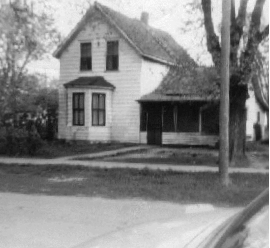
This is where the John F. Kelly family lived from 1885-1907. "Frank was
born here" is written on the back of this photo. This home is located
in the northwestern corner of Minnesota at Rush Lake, Ottertail County.
Frank Leopold Kelly was born in this house on December 16, 1893. He attended
the Rush Lake Elementary School and his teacher was Peter Ritter.
On December 16, 1893, Mary (Foltz) Kelly gave birth to Frank Leopold Kelly in her home at Rush Lake, Minnesota. During the family's Rush Lake years, 1885-1907, Mary would have other children as well. They were Francis Rose Kelly (1886), Joseph George Kelly (1890), and Cecilia Mary Kelly (1896).
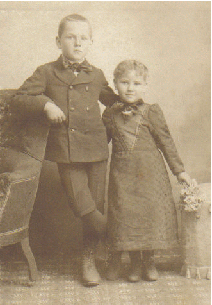
Here we see Frank Leopold Kelly and his little sister Cecilia about 1900. This represents the typical school attire for this period at the Rush Lake Elementary School. The photo, which is cropped here, has "Olson Photography Perham." The family would only stay in the Rush Lake area until 1907. That year the Rush Lake Bulletin Newspaper had an announcement that John F. Kelly was selling his land and farm equipment to move his family to Brainerd, Mn. They lived at Rush Lake between 1885-1907. This historic photo is the oldest photo we have of Frank Leopold Kelly.
Tracing the "picture" of Frank Leopold Kelly's life in these early years is quite easy. The family historian has wonderful documentation of his life and excellent photographs that can be used to reconstruct the important events of his life. We see him and his little sister pictured as early as 1900. We see his brother Joe and sister Francis Rose pictured in 1898. We see him pictured as a football player in 1907 and as a basketball player in 1910. Then he moves on to Columbus College where we see him pictured in numerous athletic pictures (1914-1915). During his courtship, early marriage, and adult life we can see Frank pictured during key historical moments. Hundreds of wonderful old pictures help us reconstruct and put together a "picture of his life."
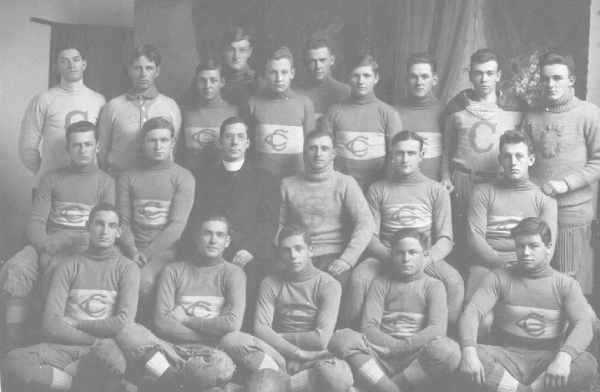
This is the Columbus College football Team circa 1914. Frank is in the back row third from the right. He is also pictured as the manager/coach of the school baseball team the same year. Columbus was a Catholic college and the Priest in the middle indicates the religious leaders supported athletics. The school was purchased by the Catholic church in 1909 and the stayed open until 1923. In 1923 the school became the Chamberlain Indian School which it still is today.
In 1907 we see a very important historical photograph. This key year for the Kelly family was caught on film. Mary Kelly and her oldest daughter Francis Rose are pictured standing in front of an old farm house with a white picket fence. This is the home that Frank was born in and where he would spend the first 14 years of his life. This would be the last year the family would live together in Rush Lake. In the Rush Lake Bulletin Newspaper a story appeared announcing the sale of all of John F. Kelly's land and property. The article announced the family was moving to Brainerd, Minnesota.
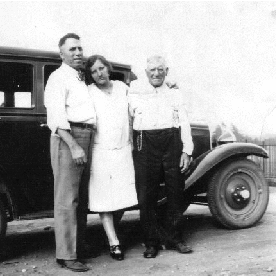
This is Frank Kelly's father John F. Kelly, 1854-1933. This picture was taken in 1929 in Fairburn, South Dakota. Joseph Kelly and Wife Ophelia are pictured with John. Joe was the oldest son in Frank's family and was a successful business man in the Black Hills area. He managed a store in Rapid City, South Dakota before opening his own store, the "Kelley Market."
This was a difficult move for the Kelly family. John F. Kelly was leaving his farm and homestead to travel to Aitkin, Minnesota to work on the Railroad. The family would soon move into a nice home on Birch Street and young Frank would attend school. He would graduate from the 8th grade in 1910 from the Aitkin school district. A wonderful story appeared in the High School yearbook that year about an 8th grade boy who helped the High School team win the Minnesota Central State Championship that year. The youngster was Frank Leopold Kelly. Frank would play again in 1911 and the team would only lose two games that year. In 1912 Frank was given a scholarship to attend Columbus College in Chamberlain, South Dakota. He didn't know it at the time, but he had officially left home forever.

Frank Kelly in the front row second from the right. Notice the basketball date 1910-1911. This team was the central Minnesota State Champs in 1910. Frank was commended in the yearbook that year for helping the team win key games although he was only an 8th grader. Information provided by the Aitkin Historical society. In 1912 Frank was accepted in Chamberlain College where he continued as an athlete.
During 1912, Frank would be a true student athlete. He would successfully complete his course work and participate in a wide variety of sporting activities. We see him picture as coach, manager, boxer, football player, basketball player, and baseball player. We also see him dressed as a horse-riding cowboy in front of the downtown Chamberlain storefronts. This wild-west appearance was very authentic for 1912. The Indian wars on the Great Plains continued on well after the 1890's. Frank was less than 100 miles from Wounded Knee South Dakota and the renegade Sioux warriors of Sitting Bull. The Black Hills to the southwest of Chamberlain was still considered dangerous Wild County. A man still needed his six-shooter. It is a point of historical fact that Frank owned one and brought it with him to Michigan.
In 1914 a key event took place in the life Frank L. Kelly. While visiting a picnic on America Island, a small island park on the Missouri River in Chamberlain, South Dakota, he meet and became infatuated with a pretty young girl named Stella Louise Thiese. Stella was a local girl and her father owned land in Alexandria, South Dakota. She was also a student/athlete and collegian. She attended the Girls' Island Business School in Grand Island, Nebraska. When they meet they were usually chaperoned, as was the tradition of the time. A picture exists of Frank and Stella at America's island in 1914. They are, of course, surrounded by Stella's family, the Thiese/Ryberg families of South Dakota. Within a year of this picture they would be married.
In 1915 Frank and Stella were married in Yankton, South Dakota. Frank soon discovered that the Thiese family of South Dakota was among the earliest settlers and homesteaders. They drove their wagons west from Iowa in the late 1800's and Stella's dad, August Thiese, owned homes in the Alexandria and White Lake regions. William Thiese, Stella's uncle, was a well known blacksmith, businessman, and custom buggy whip manufacturer in the Alexandria area. William had registered one of the first claims in the Yankton area at the federal land office.
The newlyweds left Yankton to visit Thiese family of Guttenberg, Iowa. These members of Stella's family traced their origins back to Germany. William Thiese the elder immigrated from Germany in 1865. He claimed his farm on the rich fertile flood plains of the Mississippi River and produced 14 children. Stella would introduce Frank to the family and shortly thereafter they took a job to raise a little money. During this stay in Iowa a picture exists of Frank and Stella working the soda fountain counter together in Mason City, Iowa.
Frank would then take Stella to visit his family in Minnesota. How long they stayed there is uncertain. According to family lore, Frank would leave Stella with his family while he went east to obtain a job. Frank would get a job as a projectionist for a new movie theater in downtown Escanaba, Michigan in 1917.
Stella would join him in Escanaba where they lived for less than a year. That same year Frank and Stella would move to Flint, Michigan. Frank would once again work as a projectionist, this time for the old Realta theater of Flint.
During their Flint years, 1917-1958, Frank and Stella produced a large family of seven children. At first they lived at 421 W. Fifth Street where Stella kept a detailed account of every penny in a bookkeepers ledger. This still exists. For a short time the family lived on Hector Street. Finally, they settled into a home they lived in for over 50 years, the home at 2526 Lawndale. This nice "Dutch Colonial" home, often referred to commonly as a "barn style," was a very historic style home for the Flint area. While living here Frank would land a much better job working for Buick. He began his forty-year career at Buick with an office job. He was the Administrative Assistant to O. W. Young, the General Manager of Buick. Mr. Young advised Frank to acquire some technical training to compliment his business training at college. Frank agreed to do just that.
Just before the Great Depression of 1929, Frank began taking night classes at GMI in Flint. The school was only a short distance from his home. He would eventually become a tool and die maker, a critically important technical job, and his future employment at Buick was assured. His job survived through the depression and prevented him from serving in World War II. His work building the engines of war was considered critical to the defense department. He was soon the foreman at the Grand Blank Tank Plant, in Grand Blank, Michigan. He held this position throughout the war years. Frank did join the Michigan National Guard during those years and he appeared on a list in the Flint Journal called the "Uncle Sam Roll of Honor in Flint." Stella would also work on the Ration Board from 1941-1946. Frank's youngest son Don Kelly also served in the occupation forces of Japan in 1946.
According to family lore, Frank asked to return to his old job after the war. He didn't want to continue as a foreman. He reportedly didn't like the politics of being an administrator. He was willing to do it during the war, but when the war ended he wanted out. In 1937 Frank had been an avid union supporter. Prior to the Great War the battles were being fought between labor and management, so when the workers went on strike in the "Sit-down Strike of 1937," he was an enthusiastic participant. All the workers in Flint literally sat down on the job, refusing to continue until GM agreed to negotiate a labor contract with the union. Rumors ran rampant that Federal Troops might be called into the situation.
Stella Kelly played her small part in this strike, according to family lore. She used to make up a basket of sandwiches and sneak them into the Plant 12 window under the noises of the security plant guards. After a long standoff, the union won the day and I think Frank never saw himself as a management person from then on. Although he would serve as a foreman during WWII, he returned to his union when the war ended.
Frank, throughout his life and throughout his years in Flint, 1917-1957, would always be associated with sports. He was one of the "original seven" referees in the Flint area. He coached, played for, and umped for many of the factory teams during his era. He won trophies for bowling, baseball, basketball, and more. Between 1925-1930 he coached a semi-pro basketball team in Flint. It was the team sponsored by O. W. Young, the General Manager of Buick. They played other divisions of GM all around the country. He is of course "pictured" in the official Buick Program from that era with his team.
When Don and Earl Kelly, his athletically gifted sons, were at the peak of their athletic prowess in the late 30's and early 40's, he always opened his home for the athletes after the big game and victory dance. Eddie Kruppa, who would coach for Notre Dame; Lyn Chadnois, All American from Michigan State; and Dominic Tomasi, All American from the University of Michigan, all gathered at the home of Frank Kelly to socialize. Frank's values were tied to the sporting world. It was here in the world of athletics that he formed the notion that sporting achievement coupled with an enlightened academic education were keys to success.
Both Don and Earl were indeed successful. They each made first team All State in Football and Basketball for Flint Northern. Some of their individual high school records still stand. Earl earned an athletic scholarship to play basketball for Ohio State where he also earned a degree in business. Don won an athletic scholarship to Central Michigan University where he earned his degree in teaching. He went on to coach and teach at Pontiac Northern for 30 years. Don's single game rebounding record of 26 in one game in 1952 is still the best all time performance in CMU basketball history. Earl would play professional basketball for a Columbus team and would become the owner and president of an Ohio hotel chain. So Frank did indeed pass on this love of sport and sportsmanship to his sons.

Frank and his siblings.
This picture was taken in 1941 on Frank's visit to Minnesota.
From Left to Right: Cecelia Kelly Carlson, Frank Leopold Kelly, Rose Kelly
Wise, and George Kelly.
Rose was older than Frank by many years. George graduated from Perham High School and joined the Army during World War II. He served in a bomber unit in England that took heavy casualties over Germany. He sent Frank postcards from England throughout the war. He was also an outstanding baseball player in the Perham area who started several leagues and coached. He was Frank's little brother. Francis Rose Kelly, his older sister, has one child still alive in 2004: Johanna Wise at 96.
Frank was a colorful individual who was known to smoke a cigar and take a nip of whisky on occasion. Yet, according to his daughter Dorothy Kelly, he did not smoke or drink in the house in front of the children. Stella simply would not allow it. So he was known to walk down Lawndale Avenue past St. Luke's Catholic Church to visit the pub on Friday nights. Here in the 1950's a man could have a pint of beer, a good cigar, and watch the Friday night fights on TV. Frank had himself been a fighter in college and he continued to love this manly art long after his last bout with the gloves in Chamberlain, South Dakota in 1915. When Frank's daughter Dorothy bought the family a TV in 1952, he only watched the fights and nothing else.

In fact, both Frank and Stella where atypical people for this era. It was unusual to find two parents with a high school education in the 1920's. Yet in the Kelly home of Flint we find two parents with college degrees. Since they both had over two years of college completed, they represented an unusual cultural demographic. Stella was a particularly unusual parent. Here she was, a college graduate who played on the Alexandria girls basketball team of 1908-1909. Then went on to play on her college girl's basketball team of 1911-1914. In some ways Stella's life mirrored Frank Kelly's life. They both graduated from college and played on college sporting teams. They had a lot in common right from the very beginning.
Frank must have realized that Stella was no ordinary girl. She was an intrepid, forward-thinking woman. She represented the future and she was the perfect woman to help bring a family into a world where woman would play increasingly important roles in business and sports.
Frank and Stella passed on the scholar/athlete tradition. Many of their children, grandchildren, and great-grandchildren have graduated from college. Sports and scholastic achievement have played an important role in the lives of many of there descendants.
Frank, in the 1950's, was known mostly for his umping and bowling. These were his primary loves in the twilight of his life. He traveled all over the State of Michigan to attend bowling tournaments (200 average) and to umpire sporting events. Dorothy Kelly, his daughter and statistician, often traveled with him to keep the records. Based on these experiences she became an avid sports fan herself. She also knows more about Frank Kelly than anyone in the family, so I relied on her for the information I used to write this small biography. In my many interviews with Dorothy she had a keen memory and wonderful antidotal material to share. I would like to thank Dorothy for her important contribution to this remembrance of Frank Leopold Kelly.
In 1957 Frank Leopold Kelly died. He was a man who had experienced the American West on the Great Plains of South Dakota. He had lived with pioneers and homesteaders in the hardwood forest of northwestern Minnesota. He had participated in the Industrial Revolution, the growth of General Motors, and the creation of unions. Yet somehow, I will always think of him as an athlete and scholar. This tradition seems to be his most enduring legacy. This was the glue that bonded him with Stella and so many of his sons, daughters, and grandchildren. This was the vehicle that took him from Minnesota to Flint and provided him with an interesting life. This is what worked for Frank and Stella.
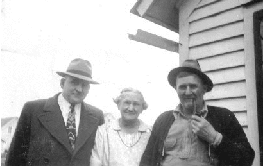
This is Frank Leopold Kelly with his mother Mary Kelly and his uncle Leopold Foltz, his name sake. Mary was born in Fort Recovery Ohio and was part of the great emigration to Minnesota in 1867. Her parents were John and Magdalena Foltz, listed as one of the "Old Settler's" of Ottertail County.

Frank Kelly the Umpire. One of Flint's original seven. Backyard of Lawndale.

FROM THE AITKIN HIGH SCHOOL 1919 YEARBOOK
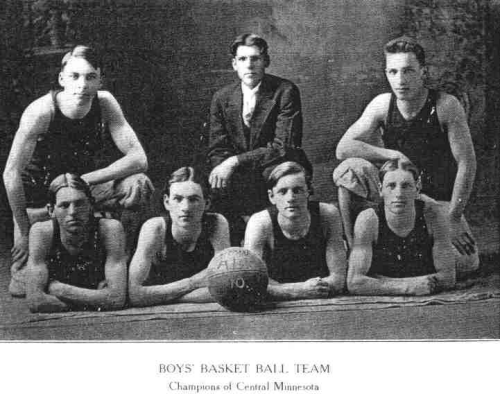
The basketball season opened with great enthusiasm on the part of those concerned. The auditorium was in almost constant use outside of school hours, as there were nine teams using it. The boys' team was aided considerably by Mr. Dales, especially in their team work and signal work. Hronesh at center went out after the Grand Rapids game, upsetting the team considerably, as a new center had to be worked out. Lueck having gone into a guard position, and Schnarr being put out of the running by an accident in the Duluth game, the material for the position was considerably cut down. Kelly, an eighth grade man, filled it creditably, however. Lueck at guard was especially strong, letting his men have but six baskets in eight games. Petraborg played an especially fine game, making forty-two buckets in one game.
Note from biographer: My grandfather Frank L. Kelly was the "eighth grade man" mentioned above. In the picture he is just to the left of the basketball with the date 1919. It is interesting I think that Frank L. Kelly would go on to coach and manage a semi pro basketball team from 1920-1930. Obviously, the lessons learned in Minnesota payed off.
THE FLINT, MICHIGAN, SEMI-PRO TEAM
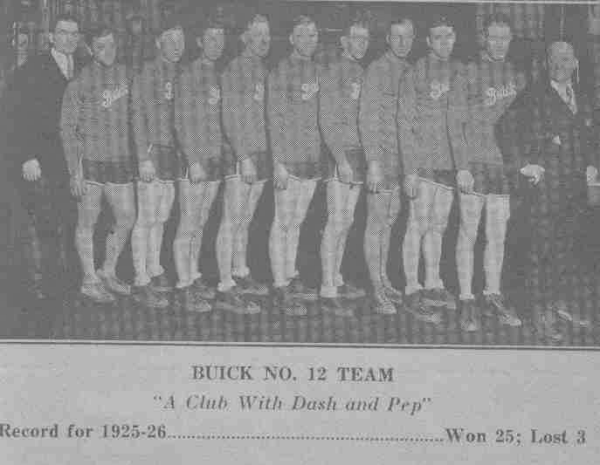
Note from biographer: My grandfather, Frank L. Kelly, was the Manager and Coach of the 1926-27 Flint Plant 12 semi pro basketball team. He is on the far left of the photo. I just wanted to show how far that "eighth grade man who filled in creditably" came with his basketball passion.

"THE STELLA THIESE KELLY STORY"
By Kelly D. Wernette
Stella was born in Postville, Iowa on August 22, 1891, the first child of August and Dorothea (Ryberg) Thiese. The Thiese family was one of thousands of German immigrants that settled in Clayton County, Iowa just after the American Civil War. William Thiese, August's father, had emigrated to Gutenberg in 1865 from Hanover, Germany. He and his brother August were successful farmers. (Note: Don't confuse August the brother with August the son.) We can conjecture that August, William's first son born in America, left home to seek success on his own around 1890, shortly after marrying Dorothea Ryberg. His first move was a short one, only 25 miles north of Gutenberg in the little town of Postville.
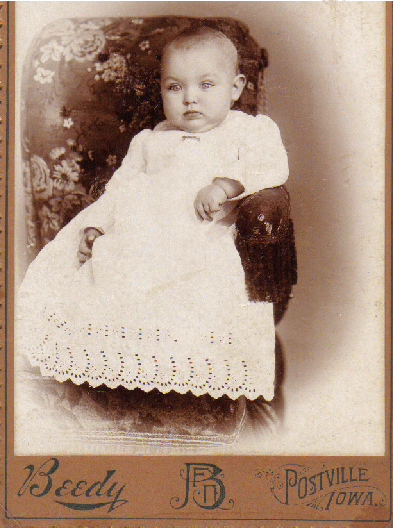
August 22, 1891~ Stella Louise Thiese was
born in Postville, Iowa.
This picture was taken of Stella during her first year.
This is one of the oldest family pictures we have.
Stella spent the first ten years of her life in Postville, Iowa. Postville
is a small town in the northeast corner of Iowa where August could live
close to his older brother Henry who was a local businessman. Henry owned
and operated the Eden restaurant in Monona and his wife Amelia owned and
operated a millinery store in Postville. Amelia's family, the "Spoo's,"
operated the local hardware store as well. We know that Stella went to a
little elementary school in Postville from 1896-1901. The Thiese family
shows up in the 1900 census as living in Grand Meadow Township, Clayton
County Iowa. There is a picture of the elementary school as well.
We know that the Thiese family moved to Alexandria, South Dakota in 1901.
The August Thiese family grew to eight children in all. They farmed over
360 acres of land and he rented even more. According to a newspaper account
of that time the family "lived on the P. F. Wickhem farm, just east of the
C. Heineman place." We know that life was difficult, dust storms common,
and that August Thiese was forced to take a job to help keep the farm going.
He worked for the P.F. Wickhem, and helped ship grain and other farm products
east to Chicago.
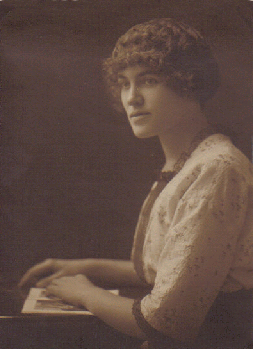
Stella
Latin for "Star"
Most of the farm work was done with teams of horses. We have pictures
of August and Eldo cutting the wheat with teams of four horses each. Aunt
Esther recalled seeing "cattle leaning up against the barn with their
ribs showing through the skin, you could count every rib." She said, "Nothing
but Russian thistle would grow." Enormous dust storms raged through the
Dakotas. Esther, Stella's younger sister, recalled "that dust would get
on everything, even our food. We used to take wet towels and try to fill
every crack and window. We even put towels around the doors."
Despite the difficulties the family lived reasonably well. In good times
the farm produced oats, corn, barley and wheat. August insisted that everyone
attend church and school and all the children could read in both English
and German. Stella was a good high school student who is pictured in 1908
with her graduating class and girls basketball team. She graduated from
Alexandria High School.
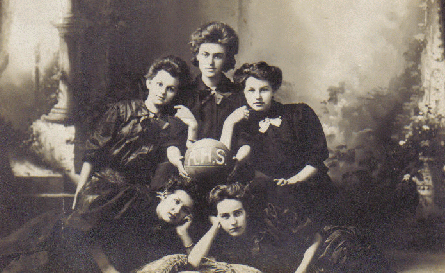
The Alexandria girls basketball team
of 1908. Stella Thiese is back center. The school supported girls
basketball despite the fact that many parents protested away games.
Often the girls would have to spend the night in the opponent's city
because of the difficulties of traveling in the "Tin Lizzies."
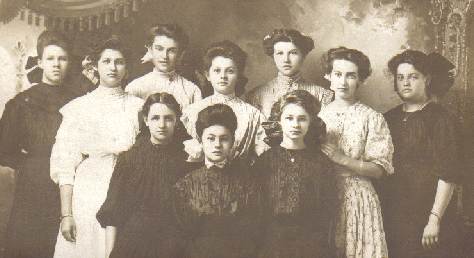
This is the Alexandria High School
graduating class of 1908. Obviously, not all of the seniors are
present here, just the girls. Stella Louise Thiese is located in
the back row, third from the left. The students of this era loved
to get their pictures taken. Women in the South Dakota area where
often more liberated than their Eastern counterparts.
August paid to have her attend the Grand Island Business College in
Grand Island, Nebraska. Stella excelled as a business student but
also found time to play on the girls' basketball team and have a leading
role in the school play. One picture exists of Stella on the stage
delivering a line. She wrote the following comments on the back of
the picture in her own handwriting: "I was the rich mother in law
and now I am giving my new son in law a lecture. The name of the picture
is ‘Too Much Mother-in-law.' Does not Ted make a swell boy? Notice
my $50.00 hat."
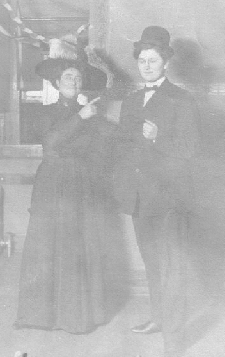
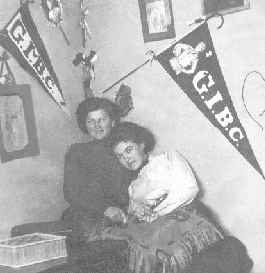
Stella with roommate at the Girls
Island Business College circa 1912. Stella pictured on the right
was a very lucky person to be attending a college that year. Most
of the girls at this school came from farm families in the mid-west.
Photo has written on back: "Irene: yours recd. This is my chum
Ted and I in our dorm. How do you like the looks of we'ens? Say
Hello to all the kids and let me hear from you. Your cousin, Stella."
This card was most like sent to her cousin Irene Thiese, daughter
of William J. Thiese, of Mitchell, South Dakota.
Another postcard from the era shows Stella with about 60 peers boarding
a passenger train. The script on the back reads: "Dad, this is me
and my gang going to Grand Island. Notice that I'm the one marked
X." She had marked a clear X on the front of the picture distinctly
on her white dress. Young women during this period appear to already
have a little more freedom to move around thanks to the trains of
that era.
Stella is seen in one photo marked "1909" with about 50 young ladies
in a group photo at the Grand Island Business School. Stella would
use this training in business to keep copious notes of trips and
expenses. She would later work on the ration board during World
War II. In 1917, she worked for Borrows in Flint, to help supplement
her husband's salary.
The big event in our family history occurred in 1914 when one Frank
Kelly escorted Stella Thiese to a picnic. This event, captured on
a photograph, which I have, shows the couple was very well chaperoned
on their first get together. No one knows the details of the romance
of Stella and Frank but we do know that in 1915 Stella and Frank
got married in Yankton, South Dakota.
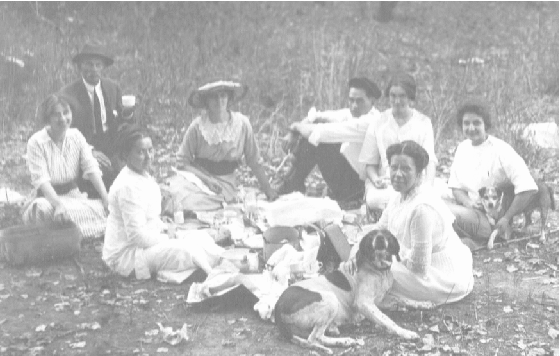
Frank Leopold Kelly and Stella
Louise Thiese, back right, are very well chaperoned on this
date in 1914 at American Island South Dakota. The other family
members are Thieses and Rybergs of South Dakota. Frank was from
Minnesota so none of his family was present. Frank was a student
at Columbus College in Chamberlain, SD. One year from this gathering
the couple would marry in Yankton, South Dakota.
One year later, we see them behind the soda counter in drug store
in Mason City, Iowa. I expect this part time work was intended
to raise some money for a future trip. The photographs represent
our only way of tracing the Kellys since no written diary was
kept. We know they stopped in Mason City because we have the picture
with a written text on the back.

Stella and Frank working the
soda fountain at Mason City, Iowa.
According to Dorothy Kelly, Frank and Stella moved next to Escanaba,
Michigan where Frank worked as a projectionist at the local
theater. Frank seems to have had a technical background since
he had attended Columbus College in Chamberlain, South Dakota.
However, they didn't stay there long because we know they arrived
in Flint, Michigan in 1917. Frank took a job working at the
Realto theater as a projectionist, and Stella worked in the
office at Borrows. The couple rented a flat at 222 Center Street
for $6.00 per week.
According to Stella's meticulously well-kept journal, Frank
earned $35.00 per week, while Stella earned a sum of $15.00
per week. Jim Kelly, Stella and Frank's first of seven children,
was born that year. One of the great documents Stella left her
family was the journal of expenses kept in 1917. German kraut
appears frequently. She left no detail unrecorded. When she
bought a copy of the police magazine, she recorded it. The aforementioned
salary figures were taken from this document.
In 1915, the year Frank and Stella married, Stella would lose
one of her young sisters, Laura Ida Sina Thiese, to diabetes.
The shock of that early death ~ Laura was only 19 ~ was followed
by the news that her grandfather, William H. Thiese of Gutenberg,
Iowa, had died. Her wedding to Frank in 1915 was the only positive
note for that year.
Bad news followed in 1919. Her brother Eldo volunteered to fight
in World War I and he was wounded. Eldo spent three months if
a field hospital in France after a poison gas attack in 1918.
Although Eldo would return home a local hero, he died in 1920
in White Lake, South Dakota. He received a military funeral
and a wonderful obituary story in the South Dakota newspaper,
which Stella kept and I now have. The local coroner of that
time determined that Eldo's death could be attributed to injuries
received during the war. Overall, 15,000 Americans would lose
their lives because of gas attacks during World War I.
In 1919, Dorothy Kelly was born and the family moved to the
wonderful barn-style home on 2526 Lawndale, Flint, Michigan.
In this house, Stella would give birth to Dorothy, Earl, Marguerite,
Frank, Ruth, and Don. They all lived in very tight quarters
in the 1920's and 1930's.
The Kellys did not appear to belong to any mainstream church
during this period. According to family lore, the Kelly Catholics
and the Thiese German Lutherans drove the couple away from both
religions. It seems that ecumenical toleration did not exist
for Frank and Stella. Being turned off to the whole thing they
never formally joined a church again. Stella did attend St.
John's church close to home, according to Dorothy Kelly. She
was known to collect recipes from the church crowd and record
them. Dorothy describes the group as an organized baking society.
An interesting footnote: Stella's confirmation certificate still
exists and every word of it is pure German.
In 1935, Dorothea Ryberg Thiese died in Mitchell, South Dakota.
Stella's mother's death brought many Thieses to Michigan. Esther
Thiese, Leonard Thiese, William Thiese, and August Thiese would
all eventually settle in Michigan. Stella would have her family
come close to home and I'm sure that pleased her greatly.
1937 saw one of the great sit-down strikes of all time in Flint.
Workers literally sat down at their workstations and refused
to leave. According to family legend, Frank was one of those
strikers. Stella was one of the brave women who delivered sandwiches
to the workers. If she would have been caught, she could have
gone to jail.
In 1941, Stella worked on the ration board for Flint, Michigan.
Apparently, a very notable Charles Stewart Mott worked on that
board with her. Mott was the founder of General Motors and reportedly
the richest man in the world at one time. In 1944, Don Kelly
served in the army. She wrote to him often and notes about his
whereabouts exist in her journal.
In both 1941 and 1944, Stella and Frank took sentimental journeys
back to see the family. In 1941, they visited Duluth to see
John F. Kelly, and Perham to visit Mary Kelly. They visited
Brainerd to see the brothers and sisters of Frank Kelly. Many
pictures were taken during this journey but no written record
was kept. However, 1944 is a completely different story. This
trip, which could be called the graveyard tour, appears to have
been a sentimental trip that took them to every important place
from their past lives. They stopped in Duluth to visit the grave
of John F. Kelly; they stopped in Brainerd to visit the grave
of Mary Kelly. They visited St. Paul, Des Moines, Mitchell,
Alexandria, Postville, and Gutenberg. They even made their way
to Grand Island, Nebraska. They visited Aunt Ida. Remarkably,
Stella kept a detailed account of every stop for gas, every
penny spent on breakfast, supper, or dinner. She noted every
cabin in every city they rented. This is a genealogical windfall
of the highest magnitude, because it spells out the important
places, burial sites, and residences of long lost relatives.
To help us out she wrote down the address and telephone numbers
of many of the folks they visited. Stella was a remarkable record
keeper.
In 1951, Jim Kelly would be killed in a fatal car crash. He
was returning home from a visit to the lake when he fell asleep
at the wheel. This was the only tragic death to one of her children
during her lifetime. We can imagine it was a huge shock. Jim
is buried next to Frank and Stella at the Sunset Hills Cemetery,
Flint, Michigan.
In 1957 Frank Kelly died. One year later, Stella Kelly followed
her husband in death. They had lived remarkable lives together
and they were missed greatly. Dorothy Kelly continued to live
at the house at 2526 Lawndale well into her 70's. Finally, in
1980 the home was sold.
Stella Thiese Kelly was a remarkable women who lived during
remarkable times. She was a pioneer feminist in a sense. She
had to be one of the first girls to play girls' basketball in
1908. She was perhaps the first female family member to attend
college (1912). She was fiercely independent in her youth, traveling
here and there by train and often unchaperoned. She worked to
support her family and served on the ration board during World
War II. She was a bright and intelligent woman who participated
in the events of her time. She risk going to jail to bring sandwiches
to striking workers.
Stella saw the last of the American Frontier in the Badlands
of South Dakota. She watched her husband Frank ride horses and
carry a six shooter. Later Frank built automobiles in Flint
Michigan. She went from the horse and buggy era to the machine
age in one lifetime. Stella Thiese Kelly was a witness to American
History. She was out in front leading the way in many ways.
This picture was taken of Stella during her first year.
This is one of the oldest family pictures we have.

Latin for "Star"
Most of the farm work was done with teams of horses. We have pictures of August and Eldo cutting the wheat with teams of four horses each. Aunt Esther recalled seeing "cattle leaning up against the barn with their ribs showing through the skin, you could count every rib." She said, "Nothing but Russian thistle would grow." Enormous dust storms raged through the Dakotas. Esther, Stella's younger sister, recalled "that dust would get on everything, even our food. We used to take wet towels and try to fill every crack and window. We even put towels around the doors."
Despite the difficulties the family lived reasonably well. In good times the farm produced oats, corn, barley and wheat. August insisted that everyone attend church and school and all the children could read in both English and German. Stella was a good high school student who is pictured in 1908 with her graduating class and girls basketball team. She graduated from Alexandria High School.

The Alexandria girls basketball team
of 1908. Stella Thiese is back center. The school supported girls
basketball despite the fact that many parents protested away games.
Often the girls would have to spend the night in the opponent's city
because of the difficulties of traveling in the "Tin Lizzies."

This is the Alexandria High School
graduating class of 1908. Obviously, not all of the seniors are
present here, just the girls. Stella Louise Thiese is located in
the back row, third from the left. The students of this era loved
to get their pictures taken. Women in the South Dakota area where
often more liberated than their Eastern counterparts.
August paid to have her attend the Grand Island Business College in
Grand Island, Nebraska. Stella excelled as a business student but
also found time to play on the girls' basketball team and have a leading
role in the school play. One picture exists of Stella on the stage
delivering a line. She wrote the following comments on the back of
the picture in her own handwriting: "I was the rich mother in law
and now I am giving my new son in law a lecture. The name of the picture
is ‘Too Much Mother-in-law.' Does not Ted make a swell boy? Notice
my $50.00 hat."


Stella with roommate at the Girls
Island Business College circa 1912. Stella pictured on the right
was a very lucky person to be attending a college that year. Most
of the girls at this school came from farm families in the mid-west.
Photo has written on back: "Irene: yours recd. This is my chum
Ted and I in our dorm. How do you like the looks of we'ens? Say
Hello to all the kids and let me hear from you. Your cousin, Stella."
This card was most like sent to her cousin Irene Thiese, daughter
of William J. Thiese, of Mitchell, South Dakota.
Another postcard from the era shows Stella with about 60 peers boarding
a passenger train. The script on the back reads: "Dad, this is me
and my gang going to Grand Island. Notice that I'm the one marked
X." She had marked a clear X on the front of the picture distinctly
on her white dress. Young women during this period appear to already
have a little more freedom to move around thanks to the trains of
that era.
Stella is seen in one photo marked "1909" with about 50 young ladies
in a group photo at the Grand Island Business School. Stella would
use this training in business to keep copious notes of trips and
expenses. She would later work on the ration board during World
War II. In 1917, she worked for Borrows in Flint, to help supplement
her husband's salary.
The big event in our family history occurred in 1914 when one Frank
Kelly escorted Stella Thiese to a picnic. This event, captured on
a photograph, which I have, shows the couple was very well chaperoned
on their first get together. No one knows the details of the romance
of Stella and Frank but we do know that in 1915 Stella and Frank
got married in Yankton, South Dakota.

Frank Leopold Kelly and Stella
Louise Thiese, back right, are very well chaperoned on this
date in 1914 at American Island South Dakota. The other family
members are Thieses and Rybergs of South Dakota. Frank was from
Minnesota so none of his family was present. Frank was a student
at Columbus College in Chamberlain, SD. One year from this gathering
the couple would marry in Yankton, South Dakota.
One year later, we see them behind the soda counter in drug store
in Mason City, Iowa. I expect this part time work was intended
to raise some money for a future trip. The photographs represent
our only way of tracing the Kellys since no written diary was
kept. We know they stopped in Mason City because we have the picture
with a written text on the back.

Stella and Frank working the
soda fountain at Mason City, Iowa.
According to Dorothy Kelly, Frank and Stella moved next to Escanaba,
Michigan where Frank worked as a projectionist at the local
theater. Frank seems to have had a technical background since
he had attended Columbus College in Chamberlain, South Dakota.
However, they didn't stay there long because we know they arrived
in Flint, Michigan in 1917. Frank took a job working at the
Realto theater as a projectionist, and Stella worked in the
office at Borrows. The couple rented a flat at 222 Center Street
for $6.00 per week.
According to Stella's meticulously well-kept journal, Frank
earned $35.00 per week, while Stella earned a sum of $15.00
per week. Jim Kelly, Stella and Frank's first of seven children,
was born that year. One of the great documents Stella left her
family was the journal of expenses kept in 1917. German kraut
appears frequently. She left no detail unrecorded. When she
bought a copy of the police magazine, she recorded it. The aforementioned
salary figures were taken from this document.
In 1915, the year Frank and Stella married, Stella would lose
one of her young sisters, Laura Ida Sina Thiese, to diabetes.
The shock of that early death ~ Laura was only 19 ~ was followed
by the news that her grandfather, William H. Thiese of Gutenberg,
Iowa, had died. Her wedding to Frank in 1915 was the only positive
note for that year.
Bad news followed in 1919. Her brother Eldo volunteered to fight
in World War I and he was wounded. Eldo spent three months if
a field hospital in France after a poison gas attack in 1918.
Although Eldo would return home a local hero, he died in 1920
in White Lake, South Dakota. He received a military funeral
and a wonderful obituary story in the South Dakota newspaper,
which Stella kept and I now have. The local coroner of that
time determined that Eldo's death could be attributed to injuries
received during the war. Overall, 15,000 Americans would lose
their lives because of gas attacks during World War I.
In 1919, Dorothy Kelly was born and the family moved to the
wonderful barn-style home on 2526 Lawndale, Flint, Michigan.
In this house, Stella would give birth to Dorothy, Earl, Marguerite,
Frank, Ruth, and Don. They all lived in very tight quarters
in the 1920's and 1930's.
The Kellys did not appear to belong to any mainstream church
during this period. According to family lore, the Kelly Catholics
and the Thiese German Lutherans drove the couple away from both
religions. It seems that ecumenical toleration did not exist
for Frank and Stella. Being turned off to the whole thing they
never formally joined a church again. Stella did attend St.
John's church close to home, according to Dorothy Kelly. She
was known to collect recipes from the church crowd and record
them. Dorothy describes the group as an organized baking society.
An interesting footnote: Stella's confirmation certificate still
exists and every word of it is pure German.
In 1935, Dorothea Ryberg Thiese died in Mitchell, South Dakota.
Stella's mother's death brought many Thieses to Michigan. Esther
Thiese, Leonard Thiese, William Thiese, and August Thiese would
all eventually settle in Michigan. Stella would have her family
come close to home and I'm sure that pleased her greatly.
1937 saw one of the great sit-down strikes of all time in Flint.
Workers literally sat down at their workstations and refused
to leave. According to family legend, Frank was one of those
strikers. Stella was one of the brave women who delivered sandwiches
to the workers. If she would have been caught, she could have
gone to jail.
In 1941, Stella worked on the ration board for Flint, Michigan.
Apparently, a very notable Charles Stewart Mott worked on that
board with her. Mott was the founder of General Motors and reportedly
the richest man in the world at one time. In 1944, Don Kelly
served in the army. She wrote to him often and notes about his
whereabouts exist in her journal.
In both 1941 and 1944, Stella and Frank took sentimental journeys
back to see the family. In 1941, they visited Duluth to see
John F. Kelly, and Perham to visit Mary Kelly. They visited
Brainerd to see the brothers and sisters of Frank Kelly. Many
pictures were taken during this journey but no written record
was kept. However, 1944 is a completely different story. This
trip, which could be called the graveyard tour, appears to have
been a sentimental trip that took them to every important place
from their past lives. They stopped in Duluth to visit the grave
of John F. Kelly; they stopped in Brainerd to visit the grave
of Mary Kelly. They visited St. Paul, Des Moines, Mitchell,
Alexandria, Postville, and Gutenberg. They even made their way
to Grand Island, Nebraska. They visited Aunt Ida. Remarkably,
Stella kept a detailed account of every stop for gas, every
penny spent on breakfast, supper, or dinner. She noted every
cabin in every city they rented. This is a genealogical windfall
of the highest magnitude, because it spells out the important
places, burial sites, and residences of long lost relatives.
To help us out she wrote down the address and telephone numbers
of many of the folks they visited. Stella was a remarkable record
keeper.
In 1951, Jim Kelly would be killed in a fatal car crash. He
was returning home from a visit to the lake when he fell asleep
at the wheel. This was the only tragic death to one of her children
during her lifetime. We can imagine it was a huge shock. Jim
is buried next to Frank and Stella at the Sunset Hills Cemetery,
Flint, Michigan.
In 1957 Frank Kelly died. One year later, Stella Kelly followed
her husband in death. They had lived remarkable lives together
and they were missed greatly. Dorothy Kelly continued to live
at the house at 2526 Lawndale well into her 70's. Finally, in
1980 the home was sold.
Stella Thiese Kelly was a remarkable women who lived during
remarkable times. She was a pioneer feminist in a sense. She
had to be one of the first girls to play girls' basketball in
1908. She was perhaps the first female family member to attend
college (1912). She was fiercely independent in her youth, traveling
here and there by train and often unchaperoned. She worked to
support her family and served on the ration board during World
War II. She was a bright and intelligent woman who participated
in the events of her time. She risk going to jail to bring sandwiches
to striking workers.
Stella saw the last of the American Frontier in the Badlands
of South Dakota. She watched her husband Frank ride horses and
carry a six shooter. Later Frank built automobiles in Flint
Michigan. She went from the horse and buggy era to the machine
age in one lifetime. Stella Thiese Kelly was a witness to American
History. She was out in front leading the way in many ways.

August paid to have her attend the Grand Island Business College in Grand Island, Nebraska. Stella excelled as a business student but also found time to play on the girls' basketball team and have a leading role in the school play. One picture exists of Stella on the stage delivering a line. She wrote the following comments on the back of the picture in her own handwriting: "I was the rich mother in law and now I am giving my new son in law a lecture. The name of the picture is ‘Too Much Mother-in-law.' Does not Ted make a swell boy? Notice my $50.00 hat."


Stella with roommate at the Girls
Island Business College circa 1912. Stella pictured on the right
was a very lucky person to be attending a college that year. Most
of the girls at this school came from farm families in the mid-west.
Photo has written on back: "Irene: yours recd. This is my chum
Ted and I in our dorm. How do you like the looks of we'ens? Say
Hello to all the kids and let me hear from you. Your cousin, Stella."
This card was most like sent to her cousin Irene Thiese, daughter
of William J. Thiese, of Mitchell, South Dakota.
Another postcard from the era shows Stella with about 60 peers boarding
a passenger train. The script on the back reads: "Dad, this is me
and my gang going to Grand Island. Notice that I'm the one marked
X." She had marked a clear X on the front of the picture distinctly
on her white dress. Young women during this period appear to already
have a little more freedom to move around thanks to the trains of
that era.
Stella is seen in one photo marked "1909" with about 50 young ladies
in a group photo at the Grand Island Business School. Stella would
use this training in business to keep copious notes of trips and
expenses. She would later work on the ration board during World
War II. In 1917, she worked for Borrows in Flint, to help supplement
her husband's salary.
The big event in our family history occurred in 1914 when one Frank
Kelly escorted Stella Thiese to a picnic. This event, captured on
a photograph, which I have, shows the couple was very well chaperoned
on their first get together. No one knows the details of the romance
of Stella and Frank but we do know that in 1915 Stella and Frank
got married in Yankton, South Dakota.

Frank Leopold Kelly and Stella
Louise Thiese, back right, are very well chaperoned on this
date in 1914 at American Island South Dakota. The other family
members are Thieses and Rybergs of South Dakota. Frank was from
Minnesota so none of his family was present. Frank was a student
at Columbus College in Chamberlain, SD. One year from this gathering
the couple would marry in Yankton, South Dakota.
One year later, we see them behind the soda counter in drug store
in Mason City, Iowa. I expect this part time work was intended
to raise some money for a future trip. The photographs represent
our only way of tracing the Kellys since no written diary was
kept. We know they stopped in Mason City because we have the picture
with a written text on the back.

Stella and Frank working the
soda fountain at Mason City, Iowa.
According to Dorothy Kelly, Frank and Stella moved next to Escanaba,
Michigan where Frank worked as a projectionist at the local
theater. Frank seems to have had a technical background since
he had attended Columbus College in Chamberlain, South Dakota.
However, they didn't stay there long because we know they arrived
in Flint, Michigan in 1917. Frank took a job working at the
Realto theater as a projectionist, and Stella worked in the
office at Borrows. The couple rented a flat at 222 Center Street
for $6.00 per week.
According to Stella's meticulously well-kept journal, Frank
earned $35.00 per week, while Stella earned a sum of $15.00
per week. Jim Kelly, Stella and Frank's first of seven children,
was born that year. One of the great documents Stella left her
family was the journal of expenses kept in 1917. German kraut
appears frequently. She left no detail unrecorded. When she
bought a copy of the police magazine, she recorded it. The aforementioned
salary figures were taken from this document.
In 1915, the year Frank and Stella married, Stella would lose
one of her young sisters, Laura Ida Sina Thiese, to diabetes.
The shock of that early death ~ Laura was only 19 ~ was followed
by the news that her grandfather, William H. Thiese of Gutenberg,
Iowa, had died. Her wedding to Frank in 1915 was the only positive
note for that year.
Bad news followed in 1919. Her brother Eldo volunteered to fight
in World War I and he was wounded. Eldo spent three months if
a field hospital in France after a poison gas attack in 1918.
Although Eldo would return home a local hero, he died in 1920
in White Lake, South Dakota. He received a military funeral
and a wonderful obituary story in the South Dakota newspaper,
which Stella kept and I now have. The local coroner of that
time determined that Eldo's death could be attributed to injuries
received during the war. Overall, 15,000 Americans would lose
their lives because of gas attacks during World War I.
In 1919, Dorothy Kelly was born and the family moved to the
wonderful barn-style home on 2526 Lawndale, Flint, Michigan.
In this house, Stella would give birth to Dorothy, Earl, Marguerite,
Frank, Ruth, and Don. They all lived in very tight quarters
in the 1920's and 1930's.
The Kellys did not appear to belong to any mainstream church
during this period. According to family lore, the Kelly Catholics
and the Thiese German Lutherans drove the couple away from both
religions. It seems that ecumenical toleration did not exist
for Frank and Stella. Being turned off to the whole thing they
never formally joined a church again. Stella did attend St.
John's church close to home, according to Dorothy Kelly. She
was known to collect recipes from the church crowd and record
them. Dorothy describes the group as an organized baking society.
An interesting footnote: Stella's confirmation certificate still
exists and every word of it is pure German.
In 1935, Dorothea Ryberg Thiese died in Mitchell, South Dakota.
Stella's mother's death brought many Thieses to Michigan. Esther
Thiese, Leonard Thiese, William Thiese, and August Thiese would
all eventually settle in Michigan. Stella would have her family
come close to home and I'm sure that pleased her greatly.
1937 saw one of the great sit-down strikes of all time in Flint.
Workers literally sat down at their workstations and refused
to leave. According to family legend, Frank was one of those
strikers. Stella was one of the brave women who delivered sandwiches
to the workers. If she would have been caught, she could have
gone to jail.
In 1941, Stella worked on the ration board for Flint, Michigan.
Apparently, a very notable Charles Stewart Mott worked on that
board with her. Mott was the founder of General Motors and reportedly
the richest man in the world at one time. In 1944, Don Kelly
served in the army. She wrote to him often and notes about his
whereabouts exist in her journal.
In both 1941 and 1944, Stella and Frank took sentimental journeys
back to see the family. In 1941, they visited Duluth to see
John F. Kelly, and Perham to visit Mary Kelly. They visited
Brainerd to see the brothers and sisters of Frank Kelly. Many
pictures were taken during this journey but no written record
was kept. However, 1944 is a completely different story. This
trip, which could be called the graveyard tour, appears to have
been a sentimental trip that took them to every important place
from their past lives. They stopped in Duluth to visit the grave
of John F. Kelly; they stopped in Brainerd to visit the grave
of Mary Kelly. They visited St. Paul, Des Moines, Mitchell,
Alexandria, Postville, and Gutenberg. They even made their way
to Grand Island, Nebraska. They visited Aunt Ida. Remarkably,
Stella kept a detailed account of every stop for gas, every
penny spent on breakfast, supper, or dinner. She noted every
cabin in every city they rented. This is a genealogical windfall
of the highest magnitude, because it spells out the important
places, burial sites, and residences of long lost relatives.
To help us out she wrote down the address and telephone numbers
of many of the folks they visited. Stella was a remarkable record
keeper.
In 1951, Jim Kelly would be killed in a fatal car crash. He
was returning home from a visit to the lake when he fell asleep
at the wheel. This was the only tragic death to one of her children
during her lifetime. We can imagine it was a huge shock. Jim
is buried next to Frank and Stella at the Sunset Hills Cemetery,
Flint, Michigan.
In 1957 Frank Kelly died. One year later, Stella Kelly followed
her husband in death. They had lived remarkable lives together
and they were missed greatly. Dorothy Kelly continued to live
at the house at 2526 Lawndale well into her 70's. Finally, in
1980 the home was sold.
Stella Thiese Kelly was a remarkable women who lived during
remarkable times. She was a pioneer feminist in a sense. She
had to be one of the first girls to play girls' basketball in
1908. She was perhaps the first female family member to attend
college (1912). She was fiercely independent in her youth, traveling
here and there by train and often unchaperoned. She worked to
support her family and served on the ration board during World
War II. She was a bright and intelligent woman who participated
in the events of her time. She risk going to jail to bring sandwiches
to striking workers.
Stella saw the last of the American Frontier in the Badlands
of South Dakota. She watched her husband Frank ride horses and
carry a six shooter. Later Frank built automobiles in Flint
Michigan. She went from the horse and buggy era to the machine
age in one lifetime. Stella Thiese Kelly was a witness to American
History. She was out in front leading the way in many ways.

One year later, we see them behind the soda counter in drug store in Mason City, Iowa. I expect this part time work was intended to raise some money for a future trip. The photographs represent our only way of tracing the Kellys since no written diary was kept. We know they stopped in Mason City because we have the picture with a written text on the back.

Stella and Frank working the
soda fountain at Mason City, Iowa.
According to Dorothy Kelly, Frank and Stella moved next to Escanaba,
Michigan where Frank worked as a projectionist at the local
theater. Frank seems to have had a technical background since
he had attended Columbus College in Chamberlain, South Dakota.
However, they didn't stay there long because we know they arrived
in Flint, Michigan in 1917. Frank took a job working at the
Realto theater as a projectionist, and Stella worked in the
office at Borrows. The couple rented a flat at 222 Center Street
for $6.00 per week.
According to Stella's meticulously well-kept journal, Frank
earned $35.00 per week, while Stella earned a sum of $15.00
per week. Jim Kelly, Stella and Frank's first of seven children,
was born that year. One of the great documents Stella left her
family was the journal of expenses kept in 1917. German kraut
appears frequently. She left no detail unrecorded. When she
bought a copy of the police magazine, she recorded it. The aforementioned
salary figures were taken from this document.
In 1915, the year Frank and Stella married, Stella would lose
one of her young sisters, Laura Ida Sina Thiese, to diabetes.
The shock of that early death ~ Laura was only 19 ~ was followed
by the news that her grandfather, William H. Thiese of Gutenberg,
Iowa, had died. Her wedding to Frank in 1915 was the only positive
note for that year.
Bad news followed in 1919. Her brother Eldo volunteered to fight
in World War I and he was wounded. Eldo spent three months if
a field hospital in France after a poison gas attack in 1918.
Although Eldo would return home a local hero, he died in 1920
in White Lake, South Dakota. He received a military funeral
and a wonderful obituary story in the South Dakota newspaper,
which Stella kept and I now have. The local coroner of that
time determined that Eldo's death could be attributed to injuries
received during the war. Overall, 15,000 Americans would lose
their lives because of gas attacks during World War I.
In 1919, Dorothy Kelly was born and the family moved to the
wonderful barn-style home on 2526 Lawndale, Flint, Michigan.
In this house, Stella would give birth to Dorothy, Earl, Marguerite,
Frank, Ruth, and Don. They all lived in very tight quarters
in the 1920's and 1930's.
The Kellys did not appear to belong to any mainstream church
during this period. According to family lore, the Kelly Catholics
and the Thiese German Lutherans drove the couple away from both
religions. It seems that ecumenical toleration did not exist
for Frank and Stella. Being turned off to the whole thing they
never formally joined a church again. Stella did attend St.
John's church close to home, according to Dorothy Kelly. She
was known to collect recipes from the church crowd and record
them. Dorothy describes the group as an organized baking society.
An interesting footnote: Stella's confirmation certificate still
exists and every word of it is pure German.
In 1935, Dorothea Ryberg Thiese died in Mitchell, South Dakota.
Stella's mother's death brought many Thieses to Michigan. Esther
Thiese, Leonard Thiese, William Thiese, and August Thiese would
all eventually settle in Michigan. Stella would have her family
come close to home and I'm sure that pleased her greatly.
1937 saw one of the great sit-down strikes of all time in Flint.
Workers literally sat down at their workstations and refused
to leave. According to family legend, Frank was one of those
strikers. Stella was one of the brave women who delivered sandwiches
to the workers. If she would have been caught, she could have
gone to jail.
In 1941, Stella worked on the ration board for Flint, Michigan.
Apparently, a very notable Charles Stewart Mott worked on that
board with her. Mott was the founder of General Motors and reportedly
the richest man in the world at one time. In 1944, Don Kelly
served in the army. She wrote to him often and notes about his
whereabouts exist in her journal.
In both 1941 and 1944, Stella and Frank took sentimental journeys
back to see the family. In 1941, they visited Duluth to see
John F. Kelly, and Perham to visit Mary Kelly. They visited
Brainerd to see the brothers and sisters of Frank Kelly. Many
pictures were taken during this journey but no written record
was kept. However, 1944 is a completely different story. This
trip, which could be called the graveyard tour, appears to have
been a sentimental trip that took them to every important place
from their past lives. They stopped in Duluth to visit the grave
of John F. Kelly; they stopped in Brainerd to visit the grave
of Mary Kelly. They visited St. Paul, Des Moines, Mitchell,
Alexandria, Postville, and Gutenberg. They even made their way
to Grand Island, Nebraska. They visited Aunt Ida. Remarkably,
Stella kept a detailed account of every stop for gas, every
penny spent on breakfast, supper, or dinner. She noted every
cabin in every city they rented. This is a genealogical windfall
of the highest magnitude, because it spells out the important
places, burial sites, and residences of long lost relatives.
To help us out she wrote down the address and telephone numbers
of many of the folks they visited. Stella was a remarkable record
keeper.
In 1951, Jim Kelly would be killed in a fatal car crash. He
was returning home from a visit to the lake when he fell asleep
at the wheel. This was the only tragic death to one of her children
during her lifetime. We can imagine it was a huge shock. Jim
is buried next to Frank and Stella at the Sunset Hills Cemetery,
Flint, Michigan.
In 1957 Frank Kelly died. One year later, Stella Kelly followed
her husband in death. They had lived remarkable lives together
and they were missed greatly. Dorothy Kelly continued to live
at the house at 2526 Lawndale well into her 70's. Finally, in
1980 the home was sold.
Stella Thiese Kelly was a remarkable women who lived during
remarkable times. She was a pioneer feminist in a sense. She
had to be one of the first girls to play girls' basketball in
1908. She was perhaps the first female family member to attend
college (1912). She was fiercely independent in her youth, traveling
here and there by train and often unchaperoned. She worked to
support her family and served on the ration board during World
War II. She was a bright and intelligent woman who participated
in the events of her time. She risk going to jail to bring sandwiches
to striking workers.
Stella saw the last of the American Frontier in the Badlands
of South Dakota. She watched her husband Frank ride horses and
carry a six shooter. Later Frank built automobiles in Flint
Michigan. She went from the horse and buggy era to the machine
age in one lifetime. Stella Thiese Kelly was a witness to American
History. She was out in front leading the way in many ways.

"MARY KELLY AND HER
CHILDREN"
By Kelly D. Wernette
Mary Kelly, nee Magdalena Foltz, was born in Fort Recovery, Ohio, on April 5th, 1866. The year of her birth was a tumultuous one. Her father, John Foltz, was selected to be a scout by his community in Fort Recovery, Ohio, and was sent to Minnesota to search for suitable land for settlement. That very year, several hundred Ohio farmers would begin the arduous journey to Minnesota. The would travel by river boat up the Mississippi to St. Paul, by train to St. Cloud, and by ox team to the northwest region of Minnesota known as Rush Lake. Here the family would settle and prosper. John Foltz was a successful farmer and auctioneer in the area until his death in 1918.

Mary's son Frank L. Kelly,
Mary, and her brother Leo
Mary's mother, Magdalena Foltz, nee Lena Doll, was surrounded
by hundreds of Dolls. Her father, Wendell Doll, lived right
next door. Wendell was born in Oensbach, Germany and he was
the father of a large family, most of whom traveled to Rush
Lake in 1866. Lena would soon, with her husband John's agreement,
assent to the marriage of her daughter Mary to John F. Kelly
in 1885.
Mary and John would live for 12 years in Rush Lake, Minnesota.
Surrounded by hundreds of family members, they produced four
children during the Rush Lake years; 1885-1907. Francis Rose
Kelly would be the first, born in 1886. Joseph George would
be born on March 2, 1890. Frank Leopold Kelly (my grandfather)
on December 16, 1893. Cecilia Mary Kelly on September 17,
1896. The Kelly family would attend school at the Rush Lake
Elementary School.

Left to right: Ceclia Kelly
Carlson, Frank Kelly, Francis Rose Kelly Wise, and George
Kelly.
Brainerd Mn., ca 1940
In 1906 Francis Rose Kelly married Joseph P. Wise. Mrs.
Joe Wise would move to Brainerd Minnesota to live with Joe
at 710 South Seventh Street. Rose was the first Kelly to
leave the nest and she produced two sons and one daughter.
Johanna Wise, at 96 years of age still lives in the old
house and sends us Christmas cards every year.
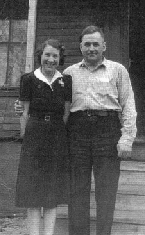
Johanna Wise, 96 years
old in 2004, is seen here with uncle Frank Kelly in
1941. She is daughter of Joe and Rose Wise.
In 1907 John F. Kelly sold his land and stock at auction.
He moved his family to Aitkin Minnesota about 100 miles
east of Rush Lake. While living at Aitkin, Minnesota,
George James Kelly was born in 1908. The children still
living at home attended Aitkin Public Schools. Frank L.
Kelly graduated from the 8th grade in 1910 and had a distinguished
career as a basketball player and athlete.
In 1915 Frank L. Kelly would marry Stella Louise Thiese
in Yankton, South Dakota. Frank was the 2nd Kelly child
to leave the nest and by 1917 he was living in Flint,
Michigan. Around this same time Cecilia Mary Kelly married
George Carlson of Des Moines, Iowa. Joseph George Kelly
would marry Orpha Schair in 1920 and move to Rapid City,
South Dakota.
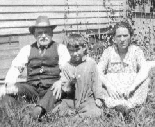
John F. Kelly, Mary's
husband; Raymond Wise; and Mary and John's daughter.
Francis Rose Kelly Wise.
Around 1918 Mary Kelly began to make frequent visits
to her married daughter, Francis, who was known as Mrs.
Joe Wise of Brainerd, Minnesota. According to newspaper
accounts she made frequent visits to see her dying father
John Foltz of Rush Lake, all travel being done by train.
Right after the death of her father in 1918, it is likely
that she separated from John F. Kelly and took her 10-year-old
son George to Perham to live with her family. She and
George would live in Perham for the next 21 years. George
would graduated from Perham High School and distinguish
himself as a baseball player of some renown. By this
time, all of Mary's children, with the one exception
of young George, were married and living with their
own families.
In 1941 George Kelly would join the army to fight during
WWII. He was a member of the 8th bomber command in England.
Even his location was a tightly guarded secret. He was
the last child to leave the nest.
In 1941 Mary Kelly moved in with her daughter Mrs. Joe
Wise of Brainerd. She would die at her daughter's house
on April 26, 1943. She is buried next to her husband
John F. Kelly, in the Evergreen Cemetery, Brainerd,
Minnesota, and Lot 32. She was 77.
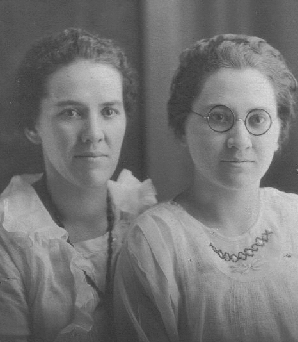
Francis Rose Kelly
Wise and Cecilia Kelly Carlson, Mary Kelly's daughters,
1930
Francis Rose Kelly, a.k.a. Mrs. Joe Wise, was born
in Rush Lake, Minnesota in 1886. She would die at
home in Brainerd, Minnesota on August 27, 1953. She
and Joe wise had three children: Johanna (1907), Frank
(1910), and Raymond (1914). Only Johanna Wise is still
alive in 2004 at the age of 96.

Mary's oldest son
Joe with his wife Orpha and Mary's husband John
F. Kelly. South Dakota 1930.
Joseph George Kelley, was born in Rush Lake Minnesota
on March 2, 1890. He would die in San Bernardino,
California on March 6, 1954. He attended Rush Lake
Elementary School in the 1890's, and Perham High
School. He would marry Orpha Schair in Rapid City
South Dakota around 1919. In the 1930's Joe and
Orpha ran the "Kelley Market" and the Fairburn Post
Office in Fairburn, South Dakota. Douglas Kelly,
their only child, was born on December 29, 1920
in Rapid City, South Dakota. The family would emigrate
west to Ontario City, San Bernardino County, California.
Joe would open the "Kelly Furniture Store" in downtown
Ontario and was elected President of the local Chamber
of Commerce. Son Douglas graduated from Ontario
Jr. College and was commissioned a Lieutenant in
the United States Marine Corp., stationed in Atlanta,
Georgia. He graduated from the Marine Corp flight
school and was a fighter pilot during the Korean
Conflict. Douglas died on July 7, 1971 from an automobile
accident in Virginia. Orpha Kelly died on September
5, 1980 in Ontario, California.
Frank Leopold Kelly, was born in Rush Lake Minnesota
on December 16, 1893. He died on June 3, 1957 in
Flint, Michigan. On August 26, 1915 he married Stella
Louise Thiese at Yankton, South Dakota. Moving to
Flint in 1917 Frank and Stella produced 7 children
and a score of grandchildren. His biography is located
above.
Cecilia Mary Kelly, a.k.a. Mrs. George Carlson,
was born in Rush Lake Minnesota in 1896. She died
on April 22, 1979 in Des Moines, Iowa. She married
George Carlson of Minnesota about 1917. The family
lived in Aberdeen City, in Brown County, South Dakota
for many years. Eventually, the family moved to
Des Moines, Iowa. The Carlsons produced no children.

Front row left
to right: George Kelly, Francis Rose Kelly Wise,
and Mr. Joseph P. Wise.
Second row left to right: Cecilia Kelly Carlson,
Joseph Kelly, Johanna Wise, and Mary Kelly.
1930
George James Kelly, was born in Aitkin, Minnesota
in 1908. George was the youngest child of John
and Mary Kelly and it is unknown if he is still
alive or dead. His last known address was Florida.
George visited his brother Frank L. Kelly, Flint,
Michigan, in 1951. Thereafter, he has disappeared
from sight. He served in the 8th Bomber command
during World War II and was stationed in England.
The unit was remembered for taking heavy casualties
during flights over Germany. His wife's name is
Dorothy.
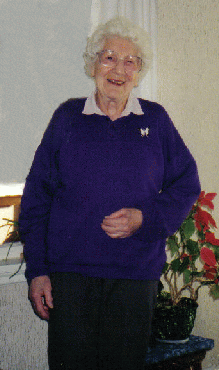
Johanna Wise
Notes from biographer: Johanna Wise, pictured
here at home, has helped me with identification
of old photographs and has sent me several photos
I have used to created this document. She still
lives in the home of her mother Francis Rose
Kelly Wise in Brainerd Minnesota at the age
of 96. This picture was taken when Francis was
89 years old on March 11, 1989. On March 8,
2004, she will turn 97 years old. We would all
like to wish her a happy birthday and thank
her for her invaluable help in doing the Kelly
genealogy.
Kelly D. Wernette, February 28, 2004.

Brainerd Mn., ca 1940
In 1906 Francis Rose Kelly married Joseph P. Wise. Mrs. Joe Wise would move to Brainerd Minnesota to live with Joe at 710 South Seventh Street. Rose was the first Kelly to leave the nest and she produced two sons and one daughter. Johanna Wise, at 96 years of age still lives in the old house and sends us Christmas cards every year.

Johanna Wise, 96 years
old in 2004, is seen here with uncle Frank Kelly in
1941. She is daughter of Joe and Rose Wise.
In 1907 John F. Kelly sold his land and stock at auction.
He moved his family to Aitkin Minnesota about 100 miles
east of Rush Lake. While living at Aitkin, Minnesota,
George James Kelly was born in 1908. The children still
living at home attended Aitkin Public Schools. Frank L.
Kelly graduated from the 8th grade in 1910 and had a distinguished
career as a basketball player and athlete.
In 1915 Frank L. Kelly would marry Stella Louise Thiese
in Yankton, South Dakota. Frank was the 2nd Kelly child
to leave the nest and by 1917 he was living in Flint,
Michigan. Around this same time Cecilia Mary Kelly married
George Carlson of Des Moines, Iowa. Joseph George Kelly
would marry Orpha Schair in 1920 and move to Rapid City,
South Dakota.

John F. Kelly, Mary's
husband; Raymond Wise; and Mary and John's daughter.
Francis Rose Kelly Wise.
Around 1918 Mary Kelly began to make frequent visits
to her married daughter, Francis, who was known as Mrs.
Joe Wise of Brainerd, Minnesota. According to newspaper
accounts she made frequent visits to see her dying father
John Foltz of Rush Lake, all travel being done by train.
Right after the death of her father in 1918, it is likely
that she separated from John F. Kelly and took her 10-year-old
son George to Perham to live with her family. She and
George would live in Perham for the next 21 years. George
would graduated from Perham High School and distinguish
himself as a baseball player of some renown. By this
time, all of Mary's children, with the one exception
of young George, were married and living with their
own families.
In 1941 George Kelly would join the army to fight during
WWII. He was a member of the 8th bomber command in England.
Even his location was a tightly guarded secret. He was
the last child to leave the nest.
In 1941 Mary Kelly moved in with her daughter Mrs. Joe
Wise of Brainerd. She would die at her daughter's house
on April 26, 1943. She is buried next to her husband
John F. Kelly, in the Evergreen Cemetery, Brainerd,
Minnesota, and Lot 32. She was 77.

Francis Rose Kelly
Wise and Cecilia Kelly Carlson, Mary Kelly's daughters,
1930
Francis Rose Kelly, a.k.a. Mrs. Joe Wise, was born
in Rush Lake, Minnesota in 1886. She would die at
home in Brainerd, Minnesota on August 27, 1953. She
and Joe wise had three children: Johanna (1907), Frank
(1910), and Raymond (1914). Only Johanna Wise is still
alive in 2004 at the age of 96.

Mary's oldest son
Joe with his wife Orpha and Mary's husband John
F. Kelly. South Dakota 1930.
Joseph George Kelley, was born in Rush Lake Minnesota
on March 2, 1890. He would die in San Bernardino,
California on March 6, 1954. He attended Rush Lake
Elementary School in the 1890's, and Perham High
School. He would marry Orpha Schair in Rapid City
South Dakota around 1919. In the 1930's Joe and
Orpha ran the "Kelley Market" and the Fairburn Post
Office in Fairburn, South Dakota. Douglas Kelly,
their only child, was born on December 29, 1920
in Rapid City, South Dakota. The family would emigrate
west to Ontario City, San Bernardino County, California.
Joe would open the "Kelly Furniture Store" in downtown
Ontario and was elected President of the local Chamber
of Commerce. Son Douglas graduated from Ontario
Jr. College and was commissioned a Lieutenant in
the United States Marine Corp., stationed in Atlanta,
Georgia. He graduated from the Marine Corp flight
school and was a fighter pilot during the Korean
Conflict. Douglas died on July 7, 1971 from an automobile
accident in Virginia. Orpha Kelly died on September
5, 1980 in Ontario, California.
Frank Leopold Kelly, was born in Rush Lake Minnesota
on December 16, 1893. He died on June 3, 1957 in
Flint, Michigan. On August 26, 1915 he married Stella
Louise Thiese at Yankton, South Dakota. Moving to
Flint in 1917 Frank and Stella produced 7 children
and a score of grandchildren. His biography is located
above.
Cecilia Mary Kelly, a.k.a. Mrs. George Carlson,
was born in Rush Lake Minnesota in 1896. She died
on April 22, 1979 in Des Moines, Iowa. She married
George Carlson of Minnesota about 1917. The family
lived in Aberdeen City, in Brown County, South Dakota
for many years. Eventually, the family moved to
Des Moines, Iowa. The Carlsons produced no children.

Front row left
to right: George Kelly, Francis Rose Kelly Wise,
and Mr. Joseph P. Wise.
Second row left to right: Cecilia Kelly Carlson,
Joseph Kelly, Johanna Wise, and Mary Kelly.
1930
George James Kelly, was born in Aitkin, Minnesota
in 1908. George was the youngest child of John
and Mary Kelly and it is unknown if he is still
alive or dead. His last known address was Florida.
George visited his brother Frank L. Kelly, Flint,
Michigan, in 1951. Thereafter, he has disappeared
from sight. He served in the 8th Bomber command
during World War II and was stationed in England.
The unit was remembered for taking heavy casualties
during flights over Germany. His wife's name is
Dorothy.

Johanna Wise
Notes from biographer: Johanna Wise, pictured
here at home, has helped me with identification
of old photographs and has sent me several photos
I have used to created this document. She still
lives in the home of her mother Francis Rose
Kelly Wise in Brainerd Minnesota at the age
of 96. This picture was taken when Francis was
89 years old on March 11, 1989. On March 8,
2004, she will turn 97 years old. We would all
like to wish her a happy birthday and thank
her for her invaluable help in doing the Kelly
genealogy.
Kelly D. Wernette, February 28, 2004.

Around 1918 Mary Kelly began to make frequent visits to her married daughter, Francis, who was known as Mrs. Joe Wise of Brainerd, Minnesota. According to newspaper accounts she made frequent visits to see her dying father John Foltz of Rush Lake, all travel being done by train. Right after the death of her father in 1918, it is likely that she separated from John F. Kelly and took her 10-year-old son George to Perham to live with her family. She and George would live in Perham for the next 21 years. George would graduated from Perham High School and distinguish himself as a baseball player of some renown. By this time, all of Mary's children, with the one exception of young George, were married and living with their own families.
In 1941 George Kelly would join the army to fight during WWII. He was a member of the 8th bomber command in England. Even his location was a tightly guarded secret. He was the last child to leave the nest.
In 1941 Mary Kelly moved in with her daughter Mrs. Joe Wise of Brainerd. She would die at her daughter's house on April 26, 1943. She is buried next to her husband John F. Kelly, in the Evergreen Cemetery, Brainerd, Minnesota, and Lot 32. She was 77.

Francis Rose Kelly
Wise and Cecilia Kelly Carlson, Mary Kelly's daughters,
1930
Francis Rose Kelly, a.k.a. Mrs. Joe Wise, was born
in Rush Lake, Minnesota in 1886. She would die at
home in Brainerd, Minnesota on August 27, 1953. She
and Joe wise had three children: Johanna (1907), Frank
(1910), and Raymond (1914). Only Johanna Wise is still
alive in 2004 at the age of 96.

Mary's oldest son
Joe with his wife Orpha and Mary's husband John
F. Kelly. South Dakota 1930.
Joseph George Kelley, was born in Rush Lake Minnesota
on March 2, 1890. He would die in San Bernardino,
California on March 6, 1954. He attended Rush Lake
Elementary School in the 1890's, and Perham High
School. He would marry Orpha Schair in Rapid City
South Dakota around 1919. In the 1930's Joe and
Orpha ran the "Kelley Market" and the Fairburn Post
Office in Fairburn, South Dakota. Douglas Kelly,
their only child, was born on December 29, 1920
in Rapid City, South Dakota. The family would emigrate
west to Ontario City, San Bernardino County, California.
Joe would open the "Kelly Furniture Store" in downtown
Ontario and was elected President of the local Chamber
of Commerce. Son Douglas graduated from Ontario
Jr. College and was commissioned a Lieutenant in
the United States Marine Corp., stationed in Atlanta,
Georgia. He graduated from the Marine Corp flight
school and was a fighter pilot during the Korean
Conflict. Douglas died on July 7, 1971 from an automobile
accident in Virginia. Orpha Kelly died on September
5, 1980 in Ontario, California.
Frank Leopold Kelly, was born in Rush Lake Minnesota
on December 16, 1893. He died on June 3, 1957 in
Flint, Michigan. On August 26, 1915 he married Stella
Louise Thiese at Yankton, South Dakota. Moving to
Flint in 1917 Frank and Stella produced 7 children
and a score of grandchildren. His biography is located
above.
Cecilia Mary Kelly, a.k.a. Mrs. George Carlson,
was born in Rush Lake Minnesota in 1896. She died
on April 22, 1979 in Des Moines, Iowa. She married
George Carlson of Minnesota about 1917. The family
lived in Aberdeen City, in Brown County, South Dakota
for many years. Eventually, the family moved to
Des Moines, Iowa. The Carlsons produced no children.

Front row left
to right: George Kelly, Francis Rose Kelly Wise,
and Mr. Joseph P. Wise.
Second row left to right: Cecilia Kelly Carlson,
Joseph Kelly, Johanna Wise, and Mary Kelly.
1930
George James Kelly, was born in Aitkin, Minnesota
in 1908. George was the youngest child of John
and Mary Kelly and it is unknown if he is still
alive or dead. His last known address was Florida.
George visited his brother Frank L. Kelly, Flint,
Michigan, in 1951. Thereafter, he has disappeared
from sight. He served in the 8th Bomber command
during World War II and was stationed in England.
The unit was remembered for taking heavy casualties
during flights over Germany. His wife's name is
Dorothy.

Johanna Wise
Notes from biographer: Johanna Wise, pictured
here at home, has helped me with identification
of old photographs and has sent me several photos
I have used to created this document. She still
lives in the home of her mother Francis Rose
Kelly Wise in Brainerd Minnesota at the age
of 96. This picture was taken when Francis was
89 years old on March 11, 1989. On March 8,
2004, she will turn 97 years old. We would all
like to wish her a happy birthday and thank
her for her invaluable help in doing the Kelly
genealogy.
Kelly D. Wernette, February 28, 2004.

Joseph George Kelley, was born in Rush Lake Minnesota on March 2, 1890. He would die in San Bernardino, California on March 6, 1954. He attended Rush Lake Elementary School in the 1890's, and Perham High School. He would marry Orpha Schair in Rapid City South Dakota around 1919. In the 1930's Joe and Orpha ran the "Kelley Market" and the Fairburn Post Office in Fairburn, South Dakota. Douglas Kelly, their only child, was born on December 29, 1920 in Rapid City, South Dakota. The family would emigrate west to Ontario City, San Bernardino County, California. Joe would open the "Kelly Furniture Store" in downtown Ontario and was elected President of the local Chamber of Commerce. Son Douglas graduated from Ontario Jr. College and was commissioned a Lieutenant in the United States Marine Corp., stationed in Atlanta, Georgia. He graduated from the Marine Corp flight school and was a fighter pilot during the Korean Conflict. Douglas died on July 7, 1971 from an automobile accident in Virginia. Orpha Kelly died on September 5, 1980 in Ontario, California.
Frank Leopold Kelly, was born in Rush Lake Minnesota on December 16, 1893. He died on June 3, 1957 in Flint, Michigan. On August 26, 1915 he married Stella Louise Thiese at Yankton, South Dakota. Moving to Flint in 1917 Frank and Stella produced 7 children and a score of grandchildren. His biography is located above.
Cecilia Mary Kelly, a.k.a. Mrs. George Carlson, was born in Rush Lake Minnesota in 1896. She died on April 22, 1979 in Des Moines, Iowa. She married George Carlson of Minnesota about 1917. The family lived in Aberdeen City, in Brown County, South Dakota for many years. Eventually, the family moved to Des Moines, Iowa. The Carlsons produced no children.

Front row left
to right: George Kelly, Francis Rose Kelly Wise,
and Mr. Joseph P. Wise.
Second row left to right: Cecilia Kelly Carlson,
Joseph Kelly, Johanna Wise, and Mary Kelly.
1930
George James Kelly, was born in Aitkin, Minnesota
in 1908. George was the youngest child of John
and Mary Kelly and it is unknown if he is still
alive or dead. His last known address was Florida.
George visited his brother Frank L. Kelly, Flint,
Michigan, in 1951. Thereafter, he has disappeared
from sight. He served in the 8th Bomber command
during World War II and was stationed in England.
The unit was remembered for taking heavy casualties
during flights over Germany. His wife's name is
Dorothy.

Johanna Wise
Notes from biographer: Johanna Wise, pictured
here at home, has helped me with identification
of old photographs and has sent me several photos
I have used to created this document. She still
lives in the home of her mother Francis Rose
Kelly Wise in Brainerd Minnesota at the age
of 96. This picture was taken when Francis was
89 years old on March 11, 1989. On March 8,
2004, she will turn 97 years old. We would all
like to wish her a happy birthday and thank
her for her invaluable help in doing the Kelly
genealogy.
Kelly D. Wernette, February 28, 2004.
Second row left to right: Cecilia Kelly Carlson, Joseph Kelly, Johanna Wise, and Mary Kelly.
1930

Notes from biographer: Johanna Wise, pictured here at home, has helped me with identification of old photographs and has sent me several photos I have used to created this document. She still lives in the home of her mother Francis Rose Kelly Wise in Brainerd Minnesota at the age of 96. This picture was taken when Francis was 89 years old on March 11, 1989. On March 8, 2004, she will turn 97 years old. We would all like to wish her a happy birthday and thank her for her invaluable help in doing the Kelly genealogy.
Kelly D. Wernette, February 28, 2004.

"THE
DOROTHY KELLY STORY"
By Kelly D. Wernette
Dorothy Kelly's parents arrived in Flint, Michigan in 1917. Stella, Dorothy's mom, gave birth to her older brother Jim that very year. However Dot, as she was called, came several years later on December 4, 1919.
After staying in several rented apartments, the family purchased a beautiful three-bedroom "Dutch Colonial" home at 2526 Lawndale, Flint, Michigan. The home's most outstanding feature is the gambrel roof, which was nicknamed the "barn style." Located in the Civic Park district of Flint, like houses of this style, it had a one-story open porch with a flat or shed roof covering the open porch. The home's architectural style was shared with many other homes in the Civic Park area and is considered a historical home today in a historic neighborhood. These were the dwellings that housed factory workers like Frank L. Kelly, Dorothy's father.
Dot's father, Frank Kelly, started off as a projectionist for the Rialto theater in downtown Flint. However, he did not like the night work and quickly switched jobs, becoming the personal secretary of O.W. Young, President of Buick Motors Company. While working in the office of Mr. Young, he took night classes to improve his skills, which eventually led to a position working as a Tool and Die Maker. His new position, working at Buick Plant 12, brought a much-needed increase in income. This would help with the growing family that swelled to seven members by 1927.
Sleeping for seven in a small house was a challenge for the Kelly seven. According to Dot, the girls and Grandma slept in the dining room and living room downstairs. Grandpa and the boys, all four of them, slept in the upstairs bedrooms. Although indoor plumbing was always a luxury the family enjoyed, it was obviously a bit crowded around the family bathroom in the morning. Privacy was a luxury none of the Kellys would experience until they left the nest. It was described by Dot as "a zoo around the house all the time."
Grandma Kelly worked for a while at "Borrows," where she was an office worker in the "Graining Office." However, when Frank landed a job as Tool and Die Maker, she moved back home to be a mom to her growing family. She would never work again, except during World War II, when she worked actively on the ration board (1942-46) for Flint. Increasingly Stella Kelly came to depend on her oldest daughter, Dorothy Kelly. Dot became a prime assistant to both Mom and Dad in managing the children in the Kelly household.
Dot recalled that Grandma Kelly used to fix a hearty and large breakfast every morning. The usual staple was oatmeal and toast. Goulash and meatloaf were the preferred dinner entrees. Baking bread, donuts, and cinnamon bread were delightful home-cooked treats. Stella with her German heritage often cooked meat, potatoes, cabbage and noodles.
According to Dot in 1927, her older brother Jim found her dad's six-shooter and fired a shot out of the upstairs window. Frank used to ride the ranges of South Dakota near the Black Hills near the Indian Territory. He was a cowboy in his youth and he had brought his six-shooter with him. Unfortunately, Jungle Jim as he was known, found the gun and decided to give it a test. Frank is reported to have buried the gun in either the backyard of the house or behind the St. John's Civic Park Church.
Dot, like all the Kelly kids, attended the Civic Park elementary school followed by Longfellow Junior High. She then attended Flint Northern High School. She loved a variety of classes but French, German, English, and Geometry were her favorites. She like school, landed parts in the school plays, and was an active member of the journalism class. She described herself at this age as "a sixteen year old snot" that was determined to "never become a cheerleader."

Dorothy Kelly
circa 1940.
This is the girl the family could depend
on.
She was never able to go out for sports. The
oldest daughter was expected to be "home before
dark" to help with the washing, ironing, and
cleaning. She said that "mother had to depend
upon me" because the younger daughters were
spoiled a bit. She did write sports stories
for her school paper and for the Flint Journal.
Frank loved to take Dot with him when he "umped"
football, basketball, and baseball. She would
record the scores, keep statistics, and write
sports summaries for her dad, which he often
turned over to the Flint Journal. She took
three years of journalism and learned to love
all things and people athletic. She did manage
to write a few stories on school dances and
the cooking classes.
She watched two very talented brothers play
for Northern. Brothers Earl and Don Kelly
played in the late 30's and early 40's. She
said although they both made All State in
Football and Basketball, they could not have
been different in both temperament and style.
Earl was a rough player who loved to mix it
up and fouled out of many basketball games.
Earl played with a group nicknamed the "wonder
boys" because they never ever lost game in
any sport. Such future greats as Lyn Chadnois
(All American, Michigan State), and Dominic
Tomasi (All American, University of Michigan),
played in that era. She remembered that Earl
kicked the winning field goal to win the 1938
State championship game against River Rouge.
This won Earl a scholarship to Ohio State
to play footballand basketball. He was their
punter for four years and played semi-pro
basketball after college.
Don was the "smooth one." He scored with a
one-handed jump shot rather than a two-handed
set shot. He was a modern player who never
fouled out of a game. Don would eventually
play basketball at Flint Junior College for
two years before transferring to Central Michigan
University. There he was the Captain of the
1952-53 team that defeated the University
of Michigan. He still holds the CMU single
game rebounding record of 26 boards for a
single game.
"It became difficult to cheer for a team,"
Dot said. "I had friends playing for both
Michigan and Michigan State." Civic Park supplied
players to almost every major sports team
in the late 30's and 40's. "I remember Lyn
Chadnois, Dominic Tamosi, Bobby Lambert and
others used to just sit around our living
room after the victory dance talking to my
brothers. We use to call them the "Haskel
Tramps."
Dorothy, like her mother Stella, was one of
the rare females to attend college. Just before
Japan bombed Pearl Harbor, she enrolled at
General Motors Institute. She carried all
A's and B's and graduated with honors, one
of the first females to do so. In the 1980's
she would return to her Alma Mater to teach
computer classes, also a first.
Around 1941 she began to work in the Distribution
department of Buick, Olds, and Pontiac. Her
income was a big help for the Kelly family
where she often was called upon to assist
other family members. This role of family
benevolent, a role she would never relinquish,
continues to this very day. She has helped
numerous family members with college tuition,
hard times, and general need. She was the
Kelly version of the "Giving Tree."
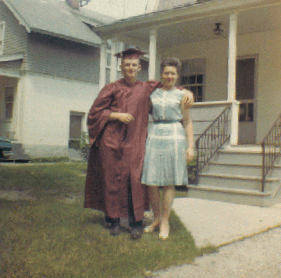
Dorothy
Kelly with nephew Kelly D. Wernette.
Barn style home in background. 1965.
Dorothy helped provide the funds for her
nephew's college education.
Dot was never to marry. She said that many
of the men she was fond of disappeared during
the war. Instead, she concentrated her efforts
on helping her family and attempting to
advance in the male dominated world of corporate
America.

Shawn
Wernette is delighted to have his book
read to him by Dorothy Kelly. She often
took an interest in the children of
family members and was always willing
to assist family members.
Dot, as an important member of General
Motors Parts Division, was in on the ground
floor of the computer transformation in
America. All parts and services for General
Motors, controlled by G.M.P.D., represented
an awesome and challenging endeavor in
the 1940's. She quickly became an expert
in knowing what went where in the world
of GM. During the war years, she was used
to train people. Dozens of men she trained
moved up the corporate ladder. She taught
them how the business works and they taught
her that it often worked better for men
then woman. She once said that she did
not want to be a supervisor. She noticed
"way too many abuses that no one would
let a woman address. It was impossible
to do what needed to be done."
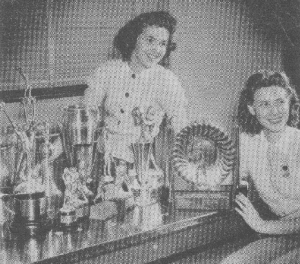
Trophy
collection removed from the Chevrolet
Parts and Service office in Flint
as part of their donation to the scrap
drive being conducted by the Old Newsboys
organization. Besides these 14 sport
trophies, quantities of metal ash
trays, rubber and other metal articles
were collected throughout the offices.
Employees Dorothy Kelly and Evelyn
Mann in photograph above.
After World War II ended, the men came
back. Many women were forced out. She
managed to survive this threat because
she was needed to train them. She recalled
that many newcomers were not just unknowledgeable
of computers, but literally scared of
computers. "They moved us into a file
room and converted it into a classroom.
They (the men) were often embarrassed
to discuss how ignorant they were in
front of the other workers. I put together
a training book that explained how car
parts and computers work together. It
was a sort of flow chart with connections
to the Data Base. We had our own language
by then and they had to learn it to
be any use in the work place. You might
say we were a foreshadowing of the world
to come," explained Dot. "The problem
was they were having difficulties seeing
the big picture. It was not just about
data and language; it was about getting
the right part to the right place efficiently.
Therefore, I simplified everything into
a nice little book, and my boss took
it to his boss and took credit for it.
In those days, you had to keep your
mouth shut. It's not like today where
they push woman into important positions.
It was different. The only women in
the fast lane in those days were the
ones who ‘piddled with the boss.'"
She said that it was not that bad. "I
was never bitter. I had lived through
the depression and I knew what real
hard times looked like. I thought my
position in life was wonderful and I
was grateful. They called me the ‘Know-Woman'
of GM and I could live with that," she
said. "I had a man's job from 1942 on
but I wasn't paid for it. GM once had
42 warehouses and I kept track of all
of them. I knew the business."
During the war, Chicago became the major
supply center for the war effort. She
closed out parts departments and sent
parts all over the country. She became
a material control person. She was assigned
more responsibility and became involved
with planning and figuring out how to
make the company money, or to save it
money. "Around 1950 the big boss called
me in and asked, "Are you getting married?"
GM had not changed much. Promotions
for women were very difficult.
By 1958, everything was done by computer.
Swartz Creek invested in super large
computers from GM and Honeywell ~ "They
super-sized it." In fact, the facility
where she worked, Auto Burn, had the
second largest computer in the world,
second only to the Pentagon. Once again,
Dot was asked to help the "boys" understand
all the aspects of programming. Data
control requires "seeing the big picture."
During the 60's and 70's, she saw the
beginning of transistor sized computers
with disc packs, which could hold more
information in less space. She volunteered
to get training in special computer
language called Fortran. Because of
this, in the mid-seventies she was asked
to go to GMI and teach Fortran to the
Engineers. GM felt that engineers must
now understand computer language and
she enthusiastically became their teacher.
"I always enjoyed the training and it
was fun to work with the young people.
They really appreciated the perspective
I brought to the classroom."
The 1960's were the beginning of Dot's
love for Michigan State football. She
bought four season tickets on about
the 35 yard line and took just about
everyone she knew to the games. Going
to one of these Saturday afternoon rituals
was something you would never forget.
You always got to East Lansing early
in the morning. You parked miles from
the football field. You always feed
the ducks on the Red Cedar river. Finally,
you watched the Michigan State band
warm-up. It always was a wonderful day
with plenty of good food, super football,
and lots of walking.
Her retirement party in 1980 was attended
by an enormous array of GM dignitaries
and high-ranking bosses, many of whom
she had trained. There was a tremendous
amount of affection displayed by all
as they wished her a happy retirement.
She returned home that night to the
only home she had ever lived in ~ the
"Dutch Colonial" on 2526 Lawndale. She
returned home after working for 39 years
for General Motors. She had one stretch
of time where she went 20 years without
missing a day's work.
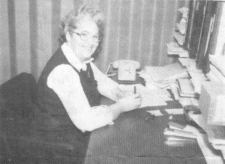
20
Years Perfect Attendance
Dorothy Kelly on the job ~ as usual
To work 20 years straight without
missing a single day would be for
most people difficult, if now impossible.
Not so, however, for Miss Dorothy
Kelly, senior scheduler and coordinator
in Administrative Control, Flint.
Joining General Motors July 29,
1941, Miss Kelly has reported to
work every day for the last 20 years,
never missing a single day. She
attributes this perfect record to
a cheerful attitude and to good
health ~ the most serious malady
she's had to contend with being
a common cold.
Miss Kelly is generally optimistic
and enjoys life. One of her greatest
pleasures is derived from "putting
a smile on peoples' faces." One
way she does this is by bringing
flowers to fellow employees from
her garden. When her supervisor,
John Potoszny, was asked to comment
bout Miss Kelly, he stated that
"she is one hell of a worker. If
there was a election for woman of
the year, Dorothy Kelly would win
hands down."
To our knowledge, 20 years perfect
attendance is a record in our Division.
Let us know it we're wrong.
Dorothy Kelly had been a career woman
long before the term became fashionable.
She never really understood "feminism"
or the "Women's Movement" the way
it is understood today. She had certainly
not been in the right place at the
right time for advancement. Yet, she
had been a pioneer of sorts. She was
woman who eventually won the respect
of everyone who ever worked with her.
She helped the cause of equality by
performance, excellence, and persistence
in a man's world, a world she lived
in for 39 years with grace and style.

Dorothy
Kelly with Laura Wernette (driving
the golf cart) and Laura's mom
Kathy Wernette during a golf tournament
for children 9-11. Dorothy often
worked for the Buick Open doing
volunteer work.
This is the girl the family could depend on.

Barn style home in background. 1965.
Dorothy helped provide the funds for her nephew's college education.
Dot was never to marry. She said that many of the men she was fond of disappeared during the war. Instead, she concentrated her efforts on helping her family and attempting to advance in the male dominated world of corporate America.

Shawn
Wernette is delighted to have his book
read to him by Dorothy Kelly. She often
took an interest in the children of
family members and was always willing
to assist family members.
Dot, as an important member of General
Motors Parts Division, was in on the ground
floor of the computer transformation in
America. All parts and services for General
Motors, controlled by G.M.P.D., represented
an awesome and challenging endeavor in
the 1940's. She quickly became an expert
in knowing what went where in the world
of GM. During the war years, she was used
to train people. Dozens of men she trained
moved up the corporate ladder. She taught
them how the business works and they taught
her that it often worked better for men
then woman. She once said that she did
not want to be a supervisor. She noticed
"way too many abuses that no one would
let a woman address. It was impossible
to do what needed to be done."

Trophy
collection removed from the Chevrolet
Parts and Service office in Flint
as part of their donation to the scrap
drive being conducted by the Old Newsboys
organization. Besides these 14 sport
trophies, quantities of metal ash
trays, rubber and other metal articles
were collected throughout the offices.
Employees Dorothy Kelly and Evelyn
Mann in photograph above.
After World War II ended, the men came
back. Many women were forced out. She
managed to survive this threat because
she was needed to train them. She recalled
that many newcomers were not just unknowledgeable
of computers, but literally scared of
computers. "They moved us into a file
room and converted it into a classroom.
They (the men) were often embarrassed
to discuss how ignorant they were in
front of the other workers. I put together
a training book that explained how car
parts and computers work together. It
was a sort of flow chart with connections
to the Data Base. We had our own language
by then and they had to learn it to
be any use in the work place. You might
say we were a foreshadowing of the world
to come," explained Dot. "The problem
was they were having difficulties seeing
the big picture. It was not just about
data and language; it was about getting
the right part to the right place efficiently.
Therefore, I simplified everything into
a nice little book, and my boss took
it to his boss and took credit for it.
In those days, you had to keep your
mouth shut. It's not like today where
they push woman into important positions.
It was different. The only women in
the fast lane in those days were the
ones who ‘piddled with the boss.'"
She said that it was not that bad. "I
was never bitter. I had lived through
the depression and I knew what real
hard times looked like. I thought my
position in life was wonderful and I
was grateful. They called me the ‘Know-Woman'
of GM and I could live with that," she
said. "I had a man's job from 1942 on
but I wasn't paid for it. GM once had
42 warehouses and I kept track of all
of them. I knew the business."
During the war, Chicago became the major
supply center for the war effort. She
closed out parts departments and sent
parts all over the country. She became
a material control person. She was assigned
more responsibility and became involved
with planning and figuring out how to
make the company money, or to save it
money. "Around 1950 the big boss called
me in and asked, "Are you getting married?"
GM had not changed much. Promotions
for women were very difficult.
By 1958, everything was done by computer.
Swartz Creek invested in super large
computers from GM and Honeywell ~ "They
super-sized it." In fact, the facility
where she worked, Auto Burn, had the
second largest computer in the world,
second only to the Pentagon. Once again,
Dot was asked to help the "boys" understand
all the aspects of programming. Data
control requires "seeing the big picture."
During the 60's and 70's, she saw the
beginning of transistor sized computers
with disc packs, which could hold more
information in less space. She volunteered
to get training in special computer
language called Fortran. Because of
this, in the mid-seventies she was asked
to go to GMI and teach Fortran to the
Engineers. GM felt that engineers must
now understand computer language and
she enthusiastically became their teacher.
"I always enjoyed the training and it
was fun to work with the young people.
They really appreciated the perspective
I brought to the classroom."
The 1960's were the beginning of Dot's
love for Michigan State football. She
bought four season tickets on about
the 35 yard line and took just about
everyone she knew to the games. Going
to one of these Saturday afternoon rituals
was something you would never forget.
You always got to East Lansing early
in the morning. You parked miles from
the football field. You always feed
the ducks on the Red Cedar river. Finally,
you watched the Michigan State band
warm-up. It always was a wonderful day
with plenty of good food, super football,
and lots of walking.
Her retirement party in 1980 was attended
by an enormous array of GM dignitaries
and high-ranking bosses, many of whom
she had trained. There was a tremendous
amount of affection displayed by all
as they wished her a happy retirement.
She returned home that night to the
only home she had ever lived in ~ the
"Dutch Colonial" on 2526 Lawndale. She
returned home after working for 39 years
for General Motors. She had one stretch
of time where she went 20 years without
missing a day's work.

20
Years Perfect Attendance
Dorothy Kelly on the job ~ as usual
To work 20 years straight without
missing a single day would be for
most people difficult, if now impossible.
Not so, however, for Miss Dorothy
Kelly, senior scheduler and coordinator
in Administrative Control, Flint.
Joining General Motors July 29,
1941, Miss Kelly has reported to
work every day for the last 20 years,
never missing a single day. She
attributes this perfect record to
a cheerful attitude and to good
health ~ the most serious malady
she's had to contend with being
a common cold.
Miss Kelly is generally optimistic
and enjoys life. One of her greatest
pleasures is derived from "putting
a smile on peoples' faces." One
way she does this is by bringing
flowers to fellow employees from
her garden. When her supervisor,
John Potoszny, was asked to comment
bout Miss Kelly, he stated that
"she is one hell of a worker. If
there was a election for woman of
the year, Dorothy Kelly would win
hands down."
To our knowledge, 20 years perfect
attendance is a record in our Division.
Let us know it we're wrong.
Dorothy Kelly had been a career woman
long before the term became fashionable.
She never really understood "feminism"
or the "Women's Movement" the way
it is understood today. She had certainly
not been in the right place at the
right time for advancement. Yet, she
had been a pioneer of sorts. She was
woman who eventually won the respect
of everyone who ever worked with her.
She helped the cause of equality by
performance, excellence, and persistence
in a man's world, a world she lived
in for 39 years with grace and style.

Dorothy
Kelly with Laura Wernette (driving
the golf cart) and Laura's mom
Kathy Wernette during a golf tournament
for children 9-11. Dorothy often
worked for the Buick Open doing
volunteer work.

After World War II ended, the men came back. Many women were forced out. She managed to survive this threat because she was needed to train them. She recalled that many newcomers were not just unknowledgeable of computers, but literally scared of computers. "They moved us into a file room and converted it into a classroom. They (the men) were often embarrassed to discuss how ignorant they were in front of the other workers. I put together a training book that explained how car parts and computers work together. It was a sort of flow chart with connections to the Data Base. We had our own language by then and they had to learn it to be any use in the work place. You might say we were a foreshadowing of the world to come," explained Dot. "The problem was they were having difficulties seeing the big picture. It was not just about data and language; it was about getting the right part to the right place efficiently. Therefore, I simplified everything into a nice little book, and my boss took it to his boss and took credit for it. In those days, you had to keep your mouth shut. It's not like today where they push woman into important positions. It was different. The only women in the fast lane in those days were the ones who ‘piddled with the boss.'"
She said that it was not that bad. "I was never bitter. I had lived through the depression and I knew what real hard times looked like. I thought my position in life was wonderful and I was grateful. They called me the ‘Know-Woman' of GM and I could live with that," she said. "I had a man's job from 1942 on but I wasn't paid for it. GM once had 42 warehouses and I kept track of all of them. I knew the business."
During the war, Chicago became the major supply center for the war effort. She closed out parts departments and sent parts all over the country. She became a material control person. She was assigned more responsibility and became involved with planning and figuring out how to make the company money, or to save it money. "Around 1950 the big boss called me in and asked, "Are you getting married?" GM had not changed much. Promotions for women were very difficult.
By 1958, everything was done by computer. Swartz Creek invested in super large computers from GM and Honeywell ~ "They super-sized it." In fact, the facility where she worked, Auto Burn, had the second largest computer in the world, second only to the Pentagon. Once again, Dot was asked to help the "boys" understand all the aspects of programming. Data control requires "seeing the big picture."
During the 60's and 70's, she saw the beginning of transistor sized computers with disc packs, which could hold more information in less space. She volunteered to get training in special computer language called Fortran. Because of this, in the mid-seventies she was asked to go to GMI and teach Fortran to the Engineers. GM felt that engineers must now understand computer language and she enthusiastically became their teacher. "I always enjoyed the training and it was fun to work with the young people. They really appreciated the perspective I brought to the classroom."
The 1960's were the beginning of Dot's love for Michigan State football. She bought four season tickets on about the 35 yard line and took just about everyone she knew to the games. Going to one of these Saturday afternoon rituals was something you would never forget. You always got to East Lansing early in the morning. You parked miles from the football field. You always feed the ducks on the Red Cedar river. Finally, you watched the Michigan State band warm-up. It always was a wonderful day with plenty of good food, super football, and lots of walking.
Her retirement party in 1980 was attended by an enormous array of GM dignitaries and high-ranking bosses, many of whom she had trained. There was a tremendous amount of affection displayed by all as they wished her a happy retirement.
She returned home that night to the only home she had ever lived in ~ the "Dutch Colonial" on 2526 Lawndale. She returned home after working for 39 years for General Motors. She had one stretch of time where she went 20 years without missing a day's work.

20
Years Perfect Attendance
Dorothy Kelly on the job ~ as usual
To work 20 years straight without
missing a single day would be for
most people difficult, if now impossible.
Not so, however, for Miss Dorothy
Kelly, senior scheduler and coordinator
in Administrative Control, Flint.
Joining General Motors July 29,
1941, Miss Kelly has reported to
work every day for the last 20 years,
never missing a single day. She
attributes this perfect record to
a cheerful attitude and to good
health ~ the most serious malady
she's had to contend with being
a common cold.
Miss Kelly is generally optimistic
and enjoys life. One of her greatest
pleasures is derived from "putting
a smile on peoples' faces." One
way she does this is by bringing
flowers to fellow employees from
her garden. When her supervisor,
John Potoszny, was asked to comment
bout Miss Kelly, he stated that
"she is one hell of a worker. If
there was a election for woman of
the year, Dorothy Kelly would win
hands down."
To our knowledge, 20 years perfect
attendance is a record in our Division.
Let us know it we're wrong.
Dorothy Kelly had been a career woman
long before the term became fashionable.
She never really understood "feminism"
or the "Women's Movement" the way
it is understood today. She had certainly
not been in the right place at the
right time for advancement. Yet, she
had been a pioneer of sorts. She was
woman who eventually won the respect
of everyone who ever worked with her.
She helped the cause of equality by
performance, excellence, and persistence
in a man's world, a world she lived
in for 39 years with grace and style.

Dorothy
Kelly with Laura Wernette (driving
the golf cart) and Laura's mom
Kathy Wernette during a golf tournament
for children 9-11. Dorothy often
worked for the Buick Open doing
volunteer work.
Dorothy Kelly on the job ~ as usual
To work 20 years straight without missing a single day would be for most people difficult, if now impossible. Not so, however, for Miss Dorothy Kelly, senior scheduler and coordinator in Administrative Control, Flint. Joining General Motors July 29, 1941, Miss Kelly has reported to work every day for the last 20 years, never missing a single day. She attributes this perfect record to a cheerful attitude and to good health ~ the most serious malady she's had to contend with being a common cold.
Miss Kelly is generally optimistic and enjoys life. One of her greatest pleasures is derived from "putting a smile on peoples' faces." One way she does this is by bringing flowers to fellow employees from her garden. When her supervisor, John Potoszny, was asked to comment bout Miss Kelly, he stated that "she is one hell of a worker. If there was a election for woman of the year, Dorothy Kelly would win hands down."
To our knowledge, 20 years perfect attendance is a record in our Division. Let us know it we're wrong.


Note from biographer: I am writing this as part of a family history project. Dorothy Kelly was responsible for my college education and if it was not for her help and benevolence I am sure I would never had made it. I, like many other members of our family, owe a deep debt of gratitude to this amazing woman. Kelly D. Wernette, a nephew
